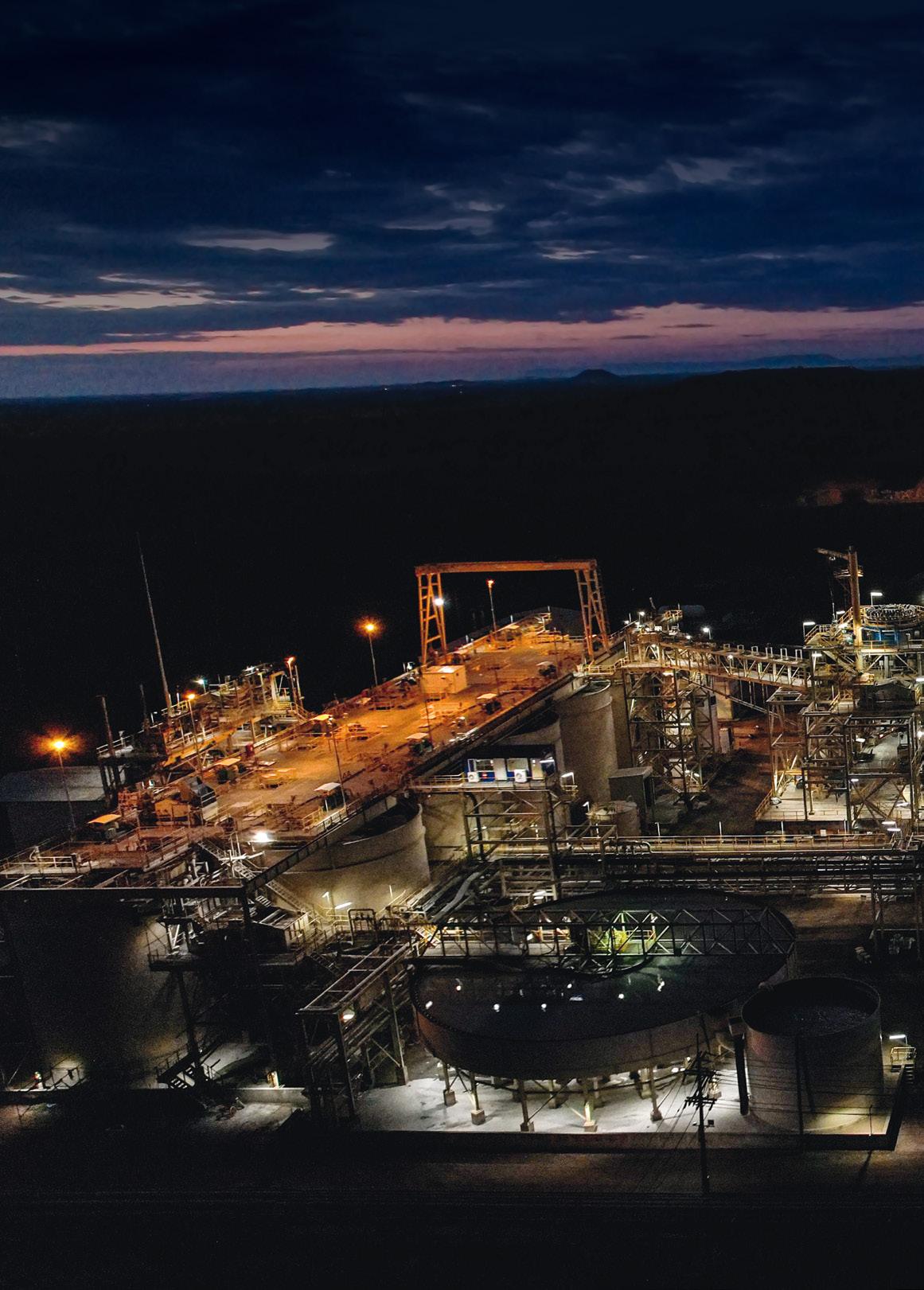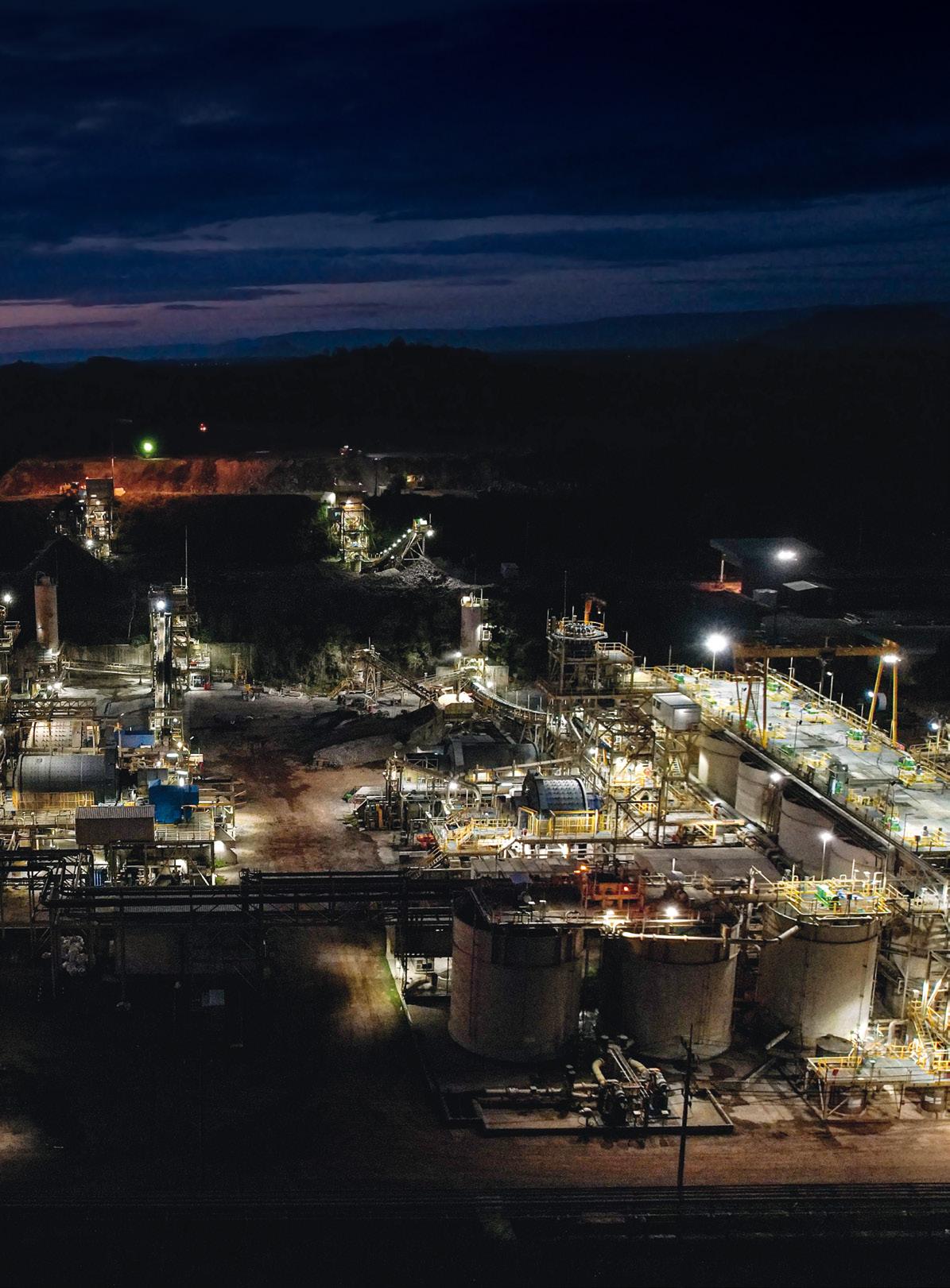






It is now almost nine years since the former military government of the Kingdom of Thailand forced your Company’s flagship Chatree Gold Mine to close, citing false environmental and health concerns. Over that time your Company’s management and Board have persevered assiduously to remedy the Company’s situation for the benefit of its long-suffering shareholders.
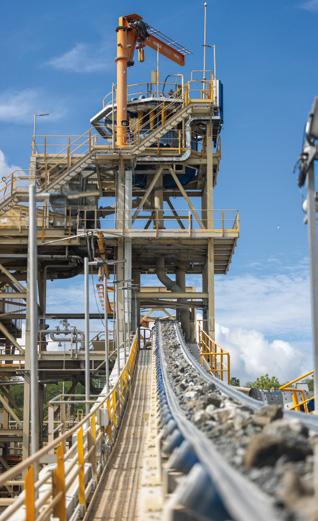
We are proud to say that we have managed to achieve what most thought was impossible and we have the mine up and running again, heading towards maximum capacity.
In the year just concluded we were able to produce just under 75,000 ounces of gold and just over 625,000 ounces of silver and have produced a net profit for the year of over A$29 million. For the ‘25 – ‘26 year we are expecting to edge it up closer to 100,000 ounces of gold and have given a guidance of 85,000 – 95,000 ounces of gold (93,000 – 103,000 ounces gold equivalent). The two parallel plants are already operating well above name-plate capacity.
During the first part of the year we were still operating mainly from low grade stockpiles, but as the year progressed this was supplemented by increasing quantities of ore from the mine as we aggressively widened and re-shaped the main pits heading down towards the main orebody. As of now virtually all ore-feed is coming from the pits and we are experiencing a gradual, although still variable, increase in ore grade.
The gold price (as well as the silver price) has continued to be very strong over the year as strong central bank buying (particularly from, but not confined to, China) continued along with major concerns about the world economy.
Although our relationship with the Thai Government has improved since the dark days of our closure, recent political events in Thailand have again caused uncertainty as to progression of the resolution of some of our outstanding issues, particularly in relation to the TAFTA award. It is to be hoped that more clarity will be evident over coming months. Unfortunately when there is uncertainty in the political sphere it is difficult to engage with the right people and to get decisions made and, although there appears to be some short-term clarification, it appears there is likely to be uncertainty for some time.
Of course political uncertainty is not confined to Thailand. In fact it seems to be more the norm in world politics. In Australia we are still
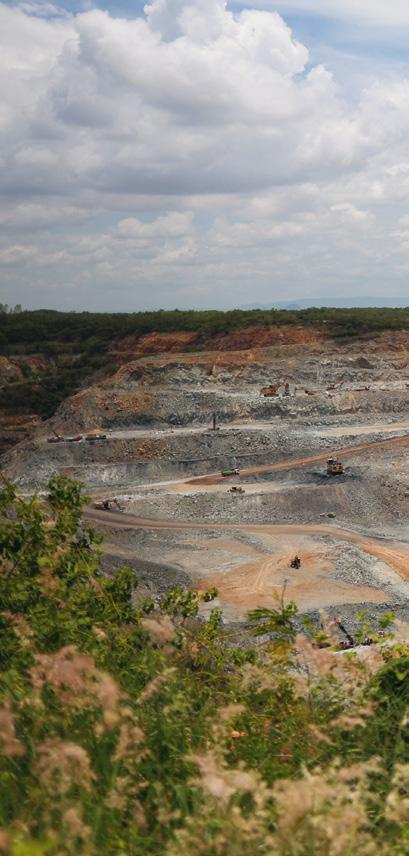
battling with the facts of a government and Prime Minister judged as close to, if not the worst, in Australia’s history, being returned, after an election, with a record majority. Its relentless pursuit of its ultimately unattainable “net zero” energy policy is seriously injurious to our economy. Given the fact that the whole climate catastrophe charade is based on an unproven hypothesis only adds to the seriousness of this illogical pursuit. Couple this with the oft-repeated lie that “renewables” are the cheapest form of energy production.
Additionally, how any government could even consider the concept of the taxation of unrealised capital gains, let alone legislate to implement it, only raises questions of the government’s competence or its real agenda.
During the year we initiated an extensive exploration campaign over a small part of the areas that we were already aware were likely to contain further orebodies. The area we have termed the “South-East Complex” is directly adjacent to our current mining leases and closer to the plant than the ‘A’ pit we are currently mining. Despite only limited access we have already proven that a large orebody exists and will significantly add to reserves and resources and guarantee a significant extension to the life of the mine. This current year we will investigate
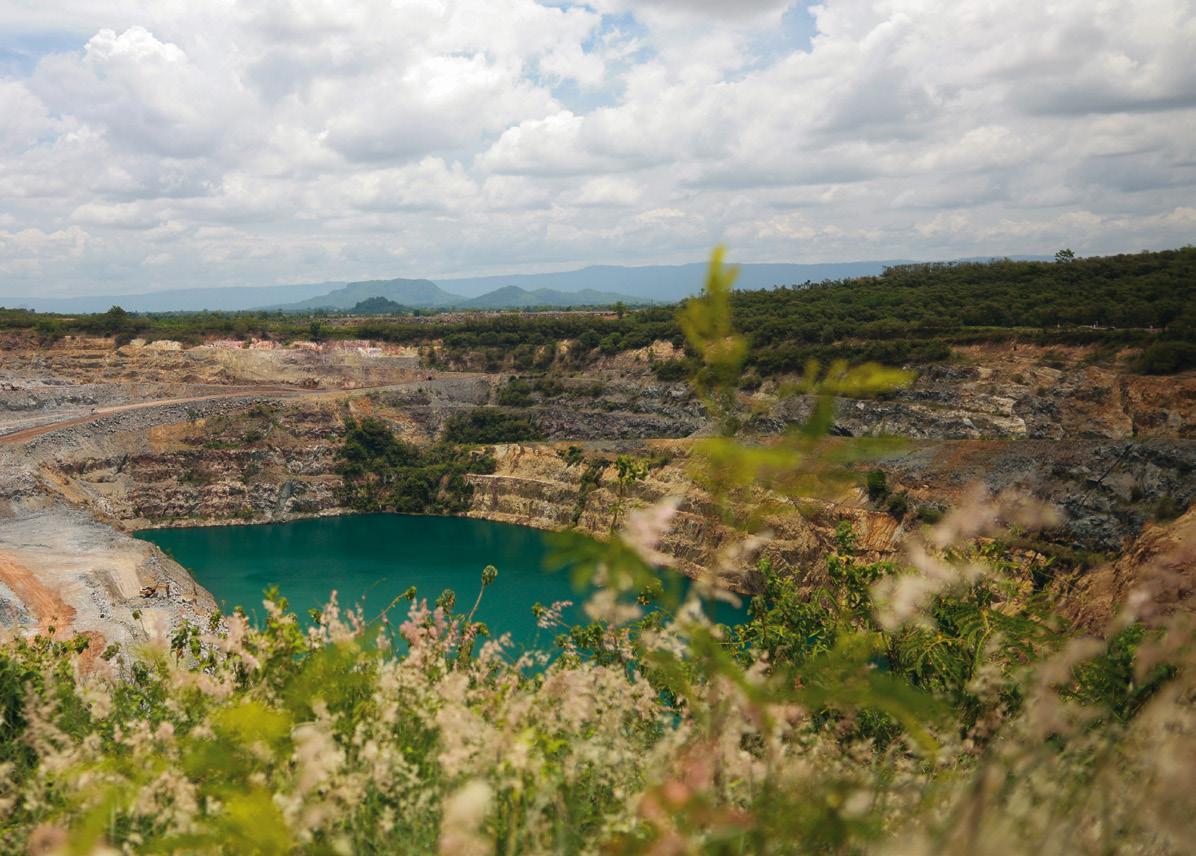
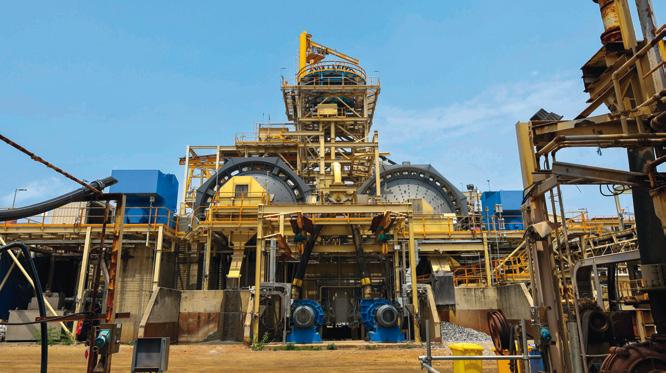
a number of other prospects that we know have indications of further mineralisation.
Also during the year the Board initiated a buy back of shares in the Company. There was little doubt that the share price had not reflected the significant progress your Company had made over a long period in resurrecting the mine. On top of that, a short position had accumulated over a long period. Now, there is no way that we
could connect the two. After all, if there was any suggestion of manipulation, either ASIC or ASX, would have picked it up and acted accordingly. However, once the buy back was commenced, and genuine buying was to the fore, miraculously the short position disappeared. Obviously only coincidental.
Enormous progress has been made in rejuvenating your Company’s flagship Chatree
Gold Mine and much praise must be given to all that have contributed to that success both at the mine and throughout our dedicated workforce. My thanks also to our incredible staff in the Sydney head office for their unquestioning support through all our ups and downs and my sincere thanks to our hard working Board traversing periods over the last few years where anybody would query the sanity of exposing oneself to the liabilities of a public company director.
As already stated, the mine is still ramping up to its previously attained level of 100,000 to 120,000 ounces of gold a year as we complete the revamp of the major ‘A’ pit and head towards the main ore body. This should be achieved during the current year and we expect increased production over coming years.
Ross Smyth-Kirk OAM Executive Chairman
Throughout the year I’ve often said that 2025 would be a transformational year for your Company, and I’m pleased to confirm that this has proven to be the case. With both processing plants now fully operational and mining activity ramping up substantially from late 2024, Kingsgate is experiencing strong growth and has achieved a number of operational milestones along the way.
Key highlights throughout FY25 include:
〉 Total recordable injury frequency rate was 2.75 per million hours worked;
〉 A full impairment reversal of the Chatree Gold Mine with a significantly higher recoverable value totalling A$228.7 million in the FY24 Full Year Accounts;
〉 Strong production performance with two consecutive quarters of gold production of over 20,000 ounces, with 74,661 ounces of gold and 625,698 ounces of silver produced for the year;
〉 An updated Mineral Resources and Ore Reserves statement for Chatree focused on the A-Pit area released in December 2024 that saw gold mineral resources increase by 13% to 3.8 million ounces at a 0.3 g/t gold cut-off grade;
〉 Processing plants continuing to exceed expectations, now operating 14% above nameplate capacity at an annualised rate of approximately 5.7 million tonnes per annum;
〉 A materially improving AISC margin of 275% from US$331 per ounce in 1Q FY25 to US$1,240 per ounce in 4Q FY25;
〉 An increase in available cash and bullion to A$69 million equivalent and total cash and bullion increasing by more than 258% during FY25 to A$84 million;
〉 Robust exploration activity, with over 30 km of reverse circulation (RC) and 4 km diamond drilling (DD) resulting in continued impressive exploration results at the Chatree South-East Complex, including;
〉 8 m @ 20.02 g/t Au from 35 – 43 m (8182DD)

〉 15 m @ 5.14 g/t Au from 1 – 16 m (8201DD)
〉 As well as at near-mine prospects including Chang Puek with 32 m @ 2.94 g/t Au from 14 – 46 m (8274RC);
〉 Successful completion of a Blast Movement Technology trial, now implemented for ore control at Chatree on an ongoing basis; and
〉 Recognition for community engagement, with Akara awarded the Department of Primary Industries and Mining (DPIM) Corporate Social Responsibility Award in February 2025.
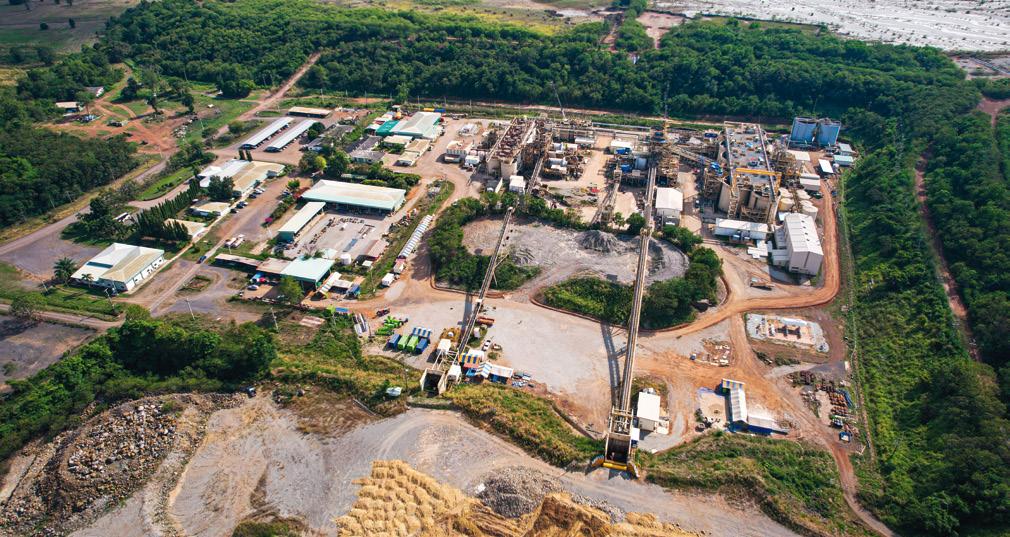
These achievements reflect your Company’s ongoing commitment to operational excellence, disciplined cost management, and building balance sheet strength. While Kingsgate remains well funded, we also commenced repayment of our debt facility with Nebari during the year, as we move swiftly to deleverage the business.
Further, FY25 also saw Kingsgate honour a long-standing commitment by undertaking an on-market share buy-back. I have long maintained that Kingsgate has been significantly undervalued, both in terms of its resource and reserve base, and on a peer comparison basis. With strong global gold and silver market fundamentals, we are now well positioned to capitalise on these favourable conditions. Pleasingly, by the close of the financial year, Kingsgate had begun to receive some of the
value recognition we believe it deserves. The focus now shifts to maintaining this positive momentum into FY26 – a challenge that both the Board and Management remain sharply focused on.
I would also like to briefly address the recent changes in the Thai political landscape. Kingsgate has a long history of maintaining constructive relationships with successive Thai Governments, and while some uncertainty remains around the current political environment, I want to reassure shareholders that we are actively leveraging these relationships to ensure business continues uninterrupted at the Chatree Gold Mine.
Equally important is the support we continue to enjoy from the local communities around Chatree. Our commitment to local employment
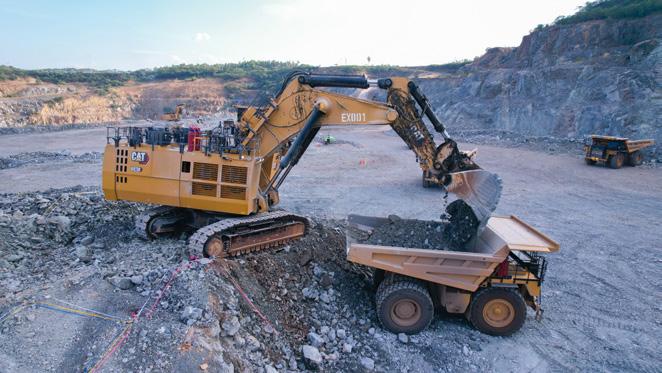
remains a cornerstone of operations, and I am pleased to report that more than 85% of our workforce are from the three provinces surrounding the mine.
Exploration also remained a priority throughout the year, delivering consistently strong results across several prospects, particularly in the near mine South-East Complex. Encouragingly, some of these outcomes are comparable to the early years of Chatree, when mining focused on supergene-enriched, near-surface ore. Over the year, over 300 holes were drilled for a total of over 35,000 metres, with the inaugural South-East Complex Resource on track for reporting in calendar year 2025.
Finally, I would like to express my sincere thanks to all Kingsgate, Akara and Laguna Resources colleagues. Your hard work and dedication have been instrumental to the good progress we are making across the Company. While mining invariably brings challenges, I am confident that together we can build on this strong foundation to deliver sustainable and long-term value for Kingsgate shareholders.
Jamie Gibson Managing Director & Chief Executive Officer
The 2025 financial year marked a major milestone for Kingsgate, with the Australian Securities Exchange (“ASX”) reclassifying the Company from an ‘exploration entity’ to a ‘mining producing entity’. This recognition coincided with a significant step-change in operations, as both Plant #1 and Plant #2 exceeded their nameplate throughput capacity during the December 2024 quarter. The year also saw the arrival of the final shipment of Caterpillar mining equipment (41 units in total), expanding the fleet to include twenty 777 haul trucks and two 6030 excavators. With this enhanced capability, Kingsgate is now well positioned to accelerate material movement and support the uplift in gold and silver production.

FY2025 saw tangible progress in mining the A Pit, with 14.8 million tonnes of material moved, including 4.5 million tonnes of ore and 10.3 million tonnes of waste, delivering a strip ratio of 2.3:1. Activity was centred on A Pit North and A Pit West respectively, supported by additional minor waste stripping along the western boundary of A Pit.
Primary ore was fed to the ROM Pad, while waste material was used for constructing TSF#2 lifts, and other key site infrastructure, with the remainder delivered to the waste dumps.
A major milestone was the completion of the TSF#2 Stage 7 lift in April 2025. During September 2025, hauling was underway to build embankments along the northern,
southern, and western sections of TSF#2, with clay placement for the Stage 8 lift ready to begin once the wet season ends. These works continue to strengthen TSF#2 foundations for ongoing mining expansion and higher throughput in the years ahead.
As at 30 June 2025, ore stockpiles were 3.6 million tonnes at an average grade of 0.43 grams of gold per tonne, representing approximately 50,000 ounces of in situ gold. These stockpiles provide a strong buffer and flexibility to support consistent mill feed going forward.
The Chatree operation continued to deliver outstanding plant performance, with both processing plants working in tandem to provide flexibility and resilience. Combined throughput

for the year reached 5.42 million tonnes, averaging 657 tonnes per hour with plant availability of 95.7% - an excellent result that underpins the strength of Chatree’s processing operations.
Processed ore averaged 0.53 grams of gold per tonne and 6.2 grams of silver per tonne, with recoveries of 82.3% for gold and 58.2% for silver respectively.
Plant #1 achieved an annual throughput of 2.08 Mtpa for the year ended 30 June 2025. Over the period, 2.07 million dry tonnes were crushed at an average feed rate of 327 tonnes per hour, with crusher availability of 93.6%. Milling performance closely matched this, with 2.08 million dry tonnes processed at an average feed rate of 252 tonnes per hour and availability of 95.8%.
Lower milling throughput during the year was largely attributable to limitations with the SAG Mill# 1 gearbox. A new gearbox for SAG Mill #1 has been purpose built that will allow a higher and more consistent throughput.
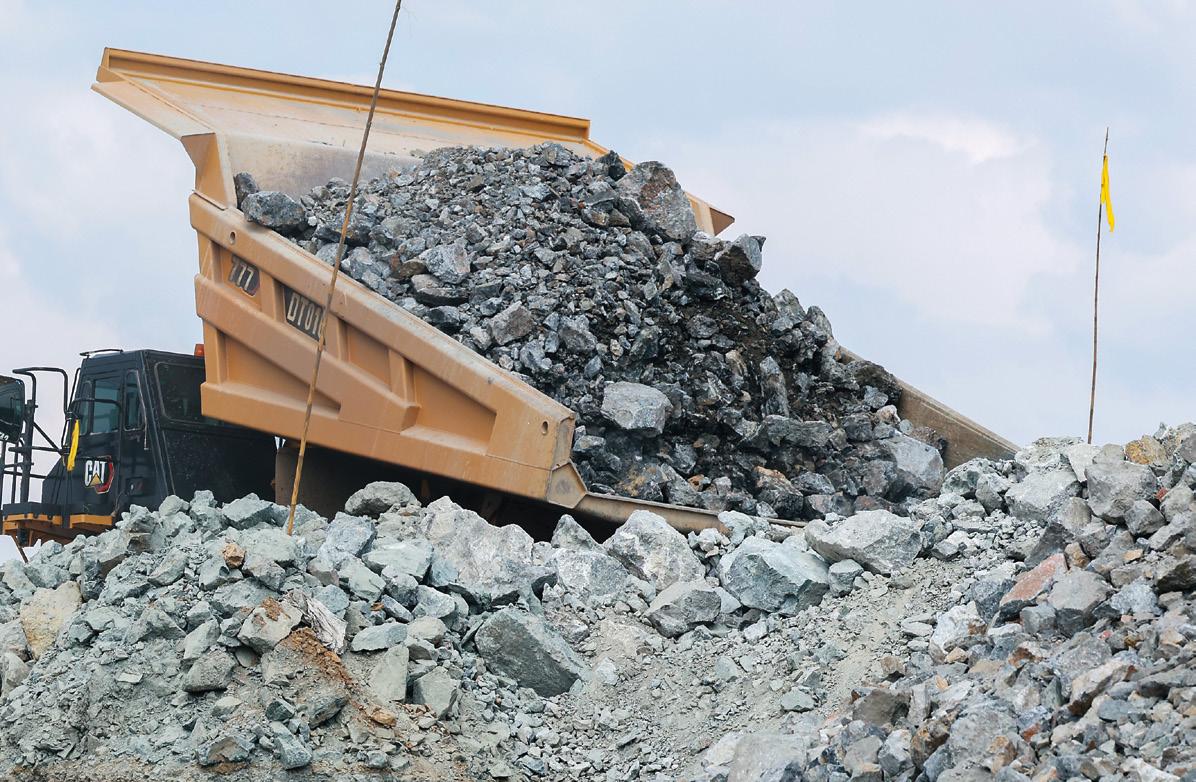

Plant #2 continued to deliver outstanding results, significantly outperforming its original 2.7 Mtpa design capacity. For the year ended 30 June 2025, throughput reached 3.34 Mtpa - a strong 24% above nameplate capacity. Average milling feed rate was 405 tonnes per hour with plant availability of 96%.
For the year ended 30 June 2025, Kingsgate delivered a strong production performance, producing 74,661 ounces of gold and 625,698 ounces of silver - a substantial increase on the prior year, and a clear reflection of the Company’s operational ramp-up and growing efficiency.
The Thailand-Australia Free Trade Agreement (TAFTA), in force since 2005, is a bilateral trade agreement between Thailand and Australia designed to promote trade, services, and investment. Among other protections, it provides Australian investors in Thailand with rights to arbitration and compensation in cases of expropriation.
In 2016, the Thai Government ordered the closure of the Chatree Gold Mine. In response, Kingsgate commenced arbitration under TAFTA to seek damages. A hearing was held in 2020, and while the tribunal was prepared to issue an award, both Kingsgate and the Thai Government agreed that reopening Chatree would deliver greater mutually benefit. The award was therefore deferred by agreement to facilitate settlement discussions.
Since then, the parties have jointly sought and obtained successive extensions of the award deferral. Following recent changes in the Thai Government, the current holding period for the arbitral award has been extended to 15 November 2025.
Kingsgate continues to engage constructively with the new Thai Government and remains committed to advancing the best interests of shareholders while appropriately balancing the interests of all stakeholders.
Kingsgate, and our subsidiary Akara Resources is committed to upholding high environmental, social and governance (ESG) standards and operating in a sustainable way that benefits shareholders, employees and local communities.
During FY25 Akara’s approach to sustainability continued to be based on a four-pillar strategy; sustainable community, educational opportunities, health and wellbeing, and clean water.
Akara actively engages with the communities surrounding the Chatree Gold Mine. Within the local community there are 28 nearby villages, with over 5,000 households and approximately 14,000 individuals. During FY25, Akara
engaged with over 8,000 of these individuals and gathered community feedback through multiple channels including in person meetings, Facebook, Line Official platform, and feedback boxes.
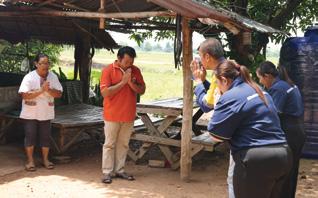
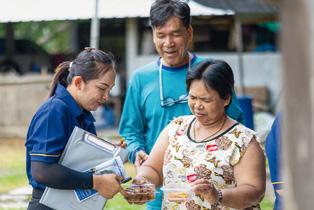
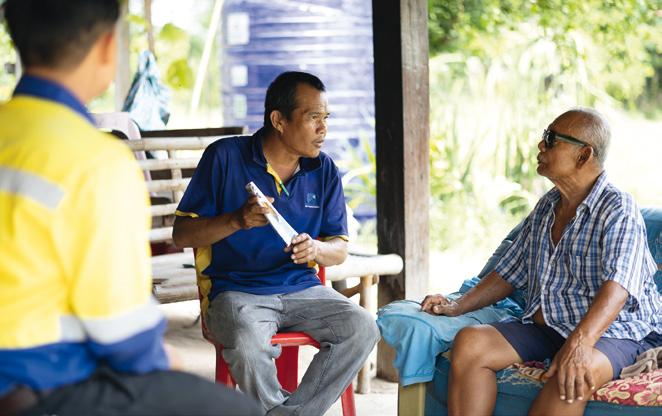
Maintained
98% Thai workforce and over 85% local employment
Visited over 3,300 local households
Participated in over 110 village meetings
Conducted a free annual health check for over 600 local residents
Recycled approximately 680 tonnes of waste
Planted
approximately 17,000 trees across 12 community forests
Maintained water quality from 16 filtration stations

Akara planted approximately 17,000 trees across 12 community forests at community tree planting events throughout the year. Akara also donated over 1,700 fruit trees to community volunteers at the planting events.
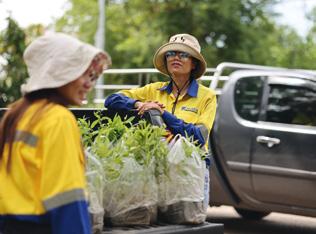

In collaboration with the Phichit Forest Centre and the Phichit Provincial Security Operations Department Akara participated in a firebreak activity across seven community forests during the dry season.


Akara participated in and supported a number of important cultural and religious community events including Buddhist Lent Day and the Songkran Festival in April 2025.
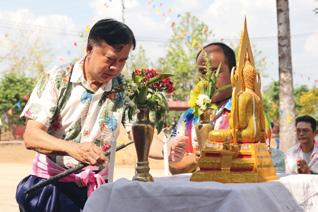
Approximately 680 tonnes of waste from the Chatree Gold Mine was recycled during the year.
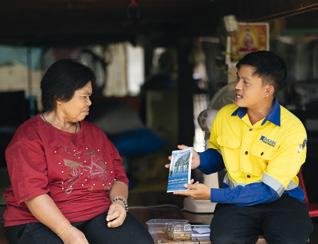
During FY25, Akara visited over 3,300 households located within 5 km of the Chatree Gold Mine. During these household visits the team listened to feedback from local residents, provided information on operations and responded to questions.
Akara participated in over 110 community meetings in villages within 5 km of the Chatree Gold Mine this year. At these meetings the team discussed projects that the various community funds support and also provided an update on operations.

Support for local schools
Akara supported a number of infrastructure projects at three schools located within 5 km of the Chatree Gold Mine, including Ban Pluaksung School, Hua Khao Ratbamrung School, and also continued its volunteer teacher program.


Scholarships
Akara participated in National Mother’s Day activities at Ban Kirithepnimit School and Ban Wang Cha Nang School. The event included engaging with monks and awarding scholarships to students.
Support Children & Family Shelter
Akara provided essential supplies and educational equipment to children and families residing in local shelters. 2

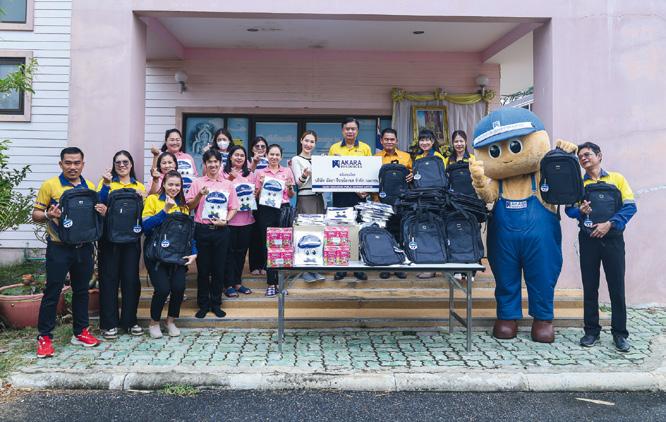
Akara hosted its annual Community Health Check event and welcomed over 600 residents from within a 5 km radius of the Chatree Gold Mine. The event was supported by Akara’s contributions to the Health Monitoring Fund. Local residents were offered complimentary health checks including x-rays and blood tests. The event was attended by key local leaders and senior members of the Department of Primary Industries and Mines.


Akara staff participated in a range of events within the community, including a charity fun run, various community sport events and also supported a local soccer team.

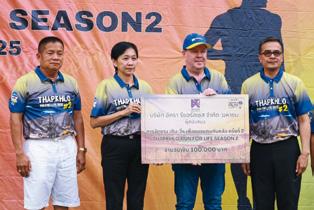
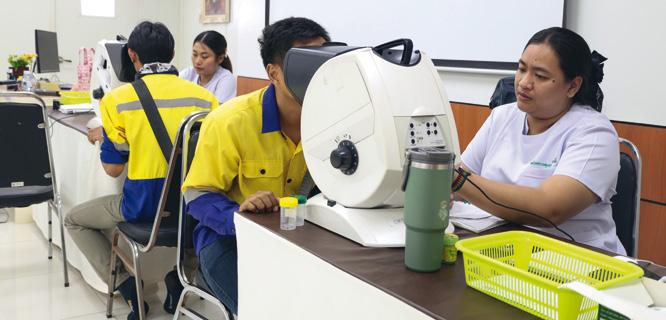
Akara conducted annual health checks and provided vaccination to employees
Akara conducted an annual health check for employees and provided influenza vaccinations.
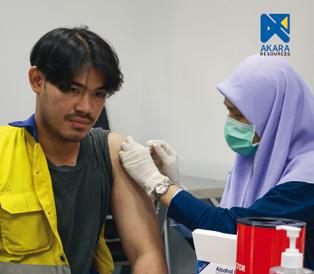
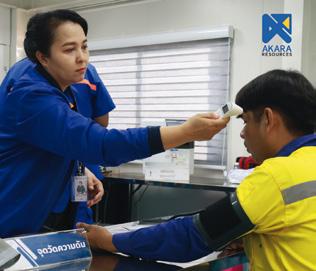
Akara participated in the Thai Red Cross Society’s annual blood donation program this year and has done so for over 20 years.
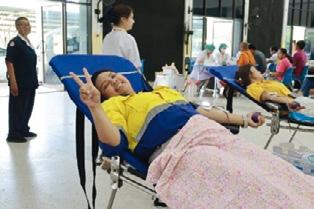
program.
Akara maintained 16 water filtration stations around the Chatree Gold Mine and monitored water quality by measuring pH, hardness, turbidity and electrical conductivity values.
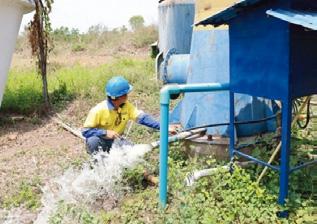
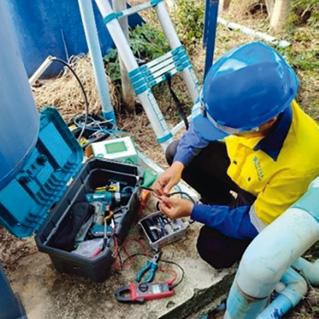
Maintaining 16 water filtration stations
During FY25 Akara supplied and donated over 200,000 water bottles to staff and the local community.

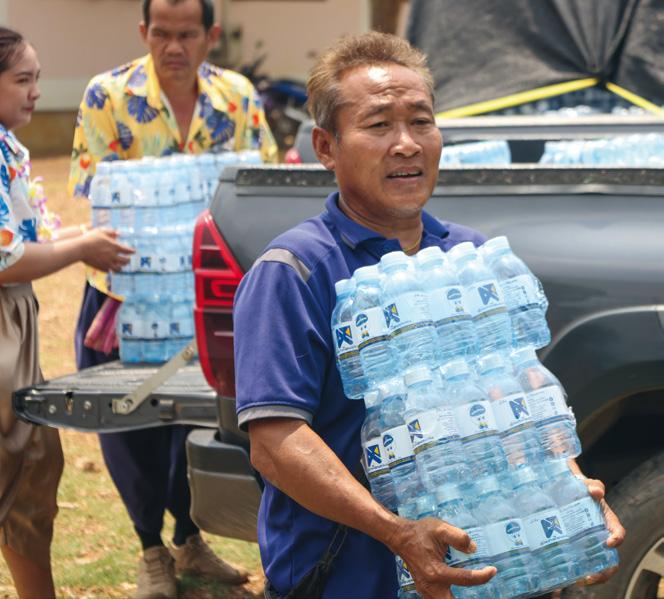

As at 30 June 2025, the total number of Akara employees was 449, with Thai nationals making up over 98% of the workforce. In addition, 85% of employees are from the local communities surrounding Chatree. Women make up 21% of Akara’s workforce and 33% of all supervisorylevel roles are held by women.
level employees
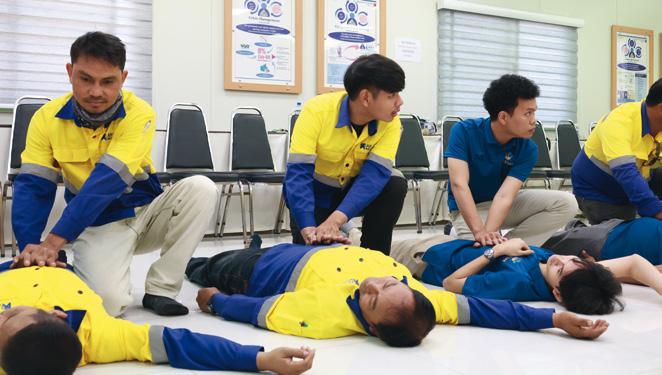
A key focus for FY25 was further strengthening health and safety initiatives at the Chatree Gold Mine. During the year, Akara staff participated in a range of annual training sessions including; first aid, rope access, chemical management and cyanide leakage training.
Chatree operates on a nil-release basis. All rain falling on the mine lease is harvested and no water leaves the site. This requires continuous management of water usage, quality and storage. A total of 24 surface water and 76 groundwater quality sampling sites have been established, all of which are regularly monitored and sampled. All measurements to date indicate that mining has had no deleterious effects.
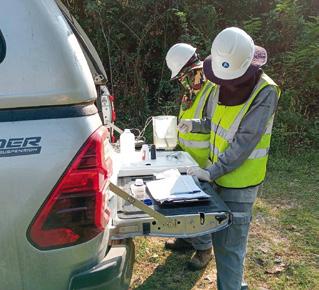
Akara Resources has been awarded the Green Industry Certification Level 1
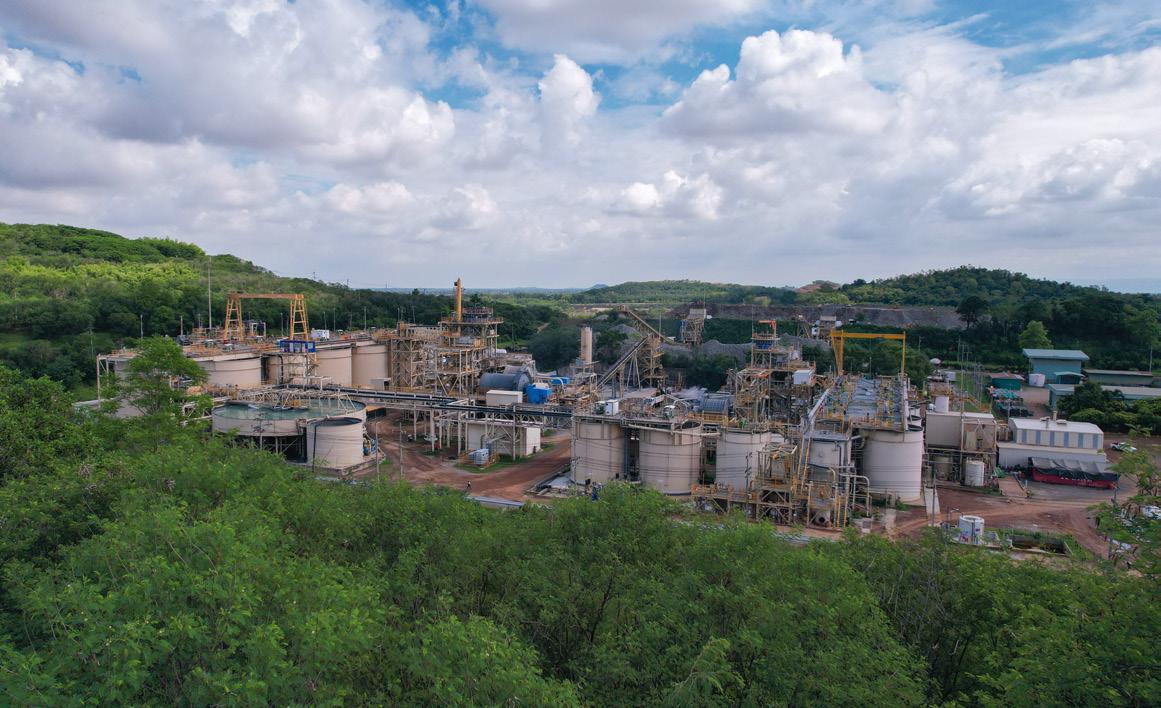
This certification signifies our dedication to minimise our environmental impact, and this commitment is effectively communicated within our organisation.
The air quality at Chatree exhibits seasonal variations, with dust and total suspended particles increasing during the dry season and decreasing in the wet season.
Independent consultants regularly monitor all nine dust monitoring stations on a quarterly basis. All recorded readings have remained below permissible threshold levels. Our confidence in maintaining effective control over on-site dust levels is supported by comprehensive road maintenance programs, which include gravel surfacing, watering, and using a rock crusher spray.
To further address environmental concerns, all disturbed areas are promptly revegetated, minimising dust during dry periods and preventing erosion in the wet season.
Noise monitoring is conducted at nine sites near the mine, while vibration measurements are taken in the seven nearest villages. The results are assessed by an independent consultant and reported to Akara and relevant government agencies on a semi-annual basis. All noise levels have remained within the guidelines issued by the Thai Ministry of Natural Resources and Environment, and vibration measurements have consistently been below those recommended by the Ministry of Science’s Control Standards for Rock Crushing Plants.
Environmental Monitoring
Surface water monitoring well
EIA 2008 Chatree North
EIA 1999 Chatree South
Current monitoring well
Ground water monitoring well
EIA 2008 Chatree North
EIA 1999 Chatree South
Current monitoring well
Kingsgate is committed to maintaining high standards of corporate governance, underpinned by a comprehensive suite of corporate policies, procedures, and training. This framework is built upon the principles and recommendations of the ASX Corporate Governance Council (Corporate Governance Principles and Recommendations 4th edition) (“ASX Recommendations”).
Kingsgate’s 2025 Corporate Governance Statement, along with the Board and Committee charters, is available on our website at https://www.kingsgate.com.au/governance/
During FY25, the priority of the Board and executive team had been on the ramp-up efforts of Chatree production as well as the ongoing discussions with the government of Thailand to resolve the long-standing TAFTA matter. These matters required substantial Board and management time and limited the extent to which all ASX Recommendations could be fully adopted during the year. This challenge is accentuated by the small size of Kingsgate’s Board and executive team.
Despite these constraints, the Board implemented a number of governance enhancements in FY25. In particular, several Board Committees were reconfigured to ensure they are chaired by a non-executive director, strengthening the independence of oversight and reinforcing Kingsgate’s commitment to incremental and progressive improvements in governance.
Building on the substantial policy review and training program rolled out in FY24, Kingsgate continued to embed refreshed governance policies across the Group in FY25, including the Code of Conduct, Anti-Bribery & Corruption Policy, Whistleblowing Policy, Diversity Policy, and Conflict of Interest Policy. Comprehensive training for Directors, officers and staff across Australia and Thailand was maintained and further expanded. The processes and controls introduced in FY24 were also further operationalised during FY25, reinforcing Kingsgate’s commitment to ethical, transparent, and accountable business practices.
The Board believes that sound corporate governance provides the basis for the future success of the Company and the Group while adding value to stakeholders and enhancing investor confidence, particularly in light of Kingsgate’s inclusion in the S&P/ASX300 on 22 September 2025. The Board is committed to progressively strengthening its governance practices in line with the Company’s evolving size, complexity, and investor base, meeting all ASX Recommendations as required under the ASX Listing Rules.
Following the recommencement of operations, Kingsgate is subject to the Australian Modern Slavery Act (Cth) 2018 and will be publishing its second Modern Slavery Statement by the end of 2025.
Kingsgate remains committed to taking steps to identify, assess, and address the modern slavery risks in its operations and supply chains, and will continue to report transparently on its efforts in future statements.
Akara was honoured to welcome distinguished visitors from the Australian Government and the Phichit Provincial Government for an official site visit to Chatree in February 2025. The delegation consisted of three senior representatives from the Department of Foreign Affairs and Trade and Austrade from the Australian Embassy in Bangkok, and the newly appointed Phichit Governor, Ms Thaniya Naiphinit and 20 representatives from the Phichit Provincial Government.
The group were given a tour of Chatree’s mining and processing operations, including the main mining pit, processing plants, tailings storage facility and gold room. The visit concluded with a productive round table discussion between the Australian and Phichit Government representatives and Akara and Kingsgate senior management.
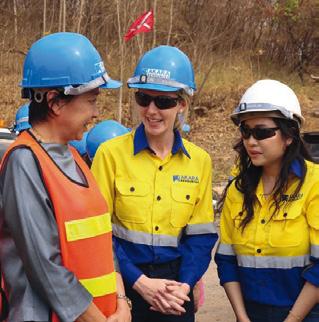
During the quarter, Akara Resources launched the ‘Akara Dream Weaving and Wisdom Sharing Project’ to nurture the potential of children and students living around the Chatree Gold Mine. The initiative provides free access to enriching educational and recreational activities during school holidays, addressing community-identified needs for structured, skill-building programs.
Courses offered include English, Chinese, Traditional Thai and Foreign Music, Thai Boxing, and art, catering to children aged 5-12.

In February, Akara was honoured to receive the CSR-DPIM 2024 award for meeting the social responsibility standards set by the Department of Primary Industries and Mining (DPIM) for the mining and primary industry sector.
This recognition underscores Akara’s commitment to operating in an environmentally responsible and socially conscious manner, aligning with the DPIM’s strategy to encourage businesses to operate in a sustainable manner.
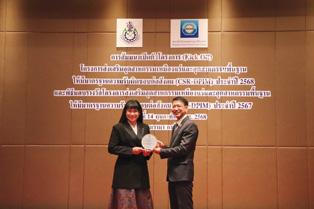
Nueva Esperanza is a prefeasibility-stage gold and silver development project, located in the Maricunga Belt in the Atacama region of Chile. Updated Mineral Resources and Ore Reserves estimates were published on 10 October 2025 (refer Mineral Resources and Ore Reserves Statement October 2025 available to view on www.kingsgate.com.au). These estimates were informed by a comprehensive review, validation, and modelling of all available drill and modifying factor data.
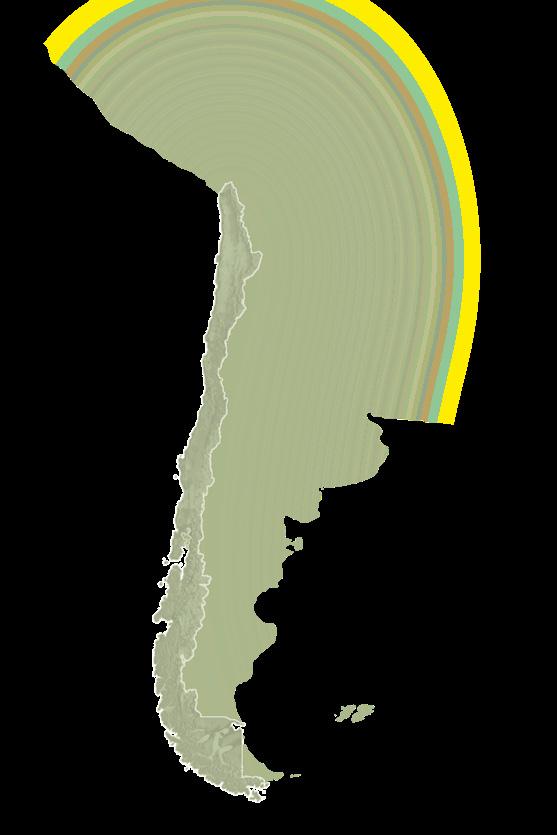
During the year ended 30 June 2025, Kingsgate continued to explore opportunities to advance the project. A geochemical sampling and assessment program was conducted across prospective areas beyond the current resource footprint, and additional hydrogeological studies were initiated to support future development planning. A hydrogeological consultant and specialist legal counsel were also appointed during the year to ensure that the project remains in good stead.
Kingsgate continues to explore all options available to advance the project to unlock further value for shareholders including a separate listing of the asset in the North Americas, a joint venture or sale. Further updates will be provided in due course as the project progresses.


Exploration programs were conducted on 17 Phetchabun Special Prospecting Licenses (SPL). Field activities included geological mapping, rock chip and soil sampling. Drilling included Rotary Air Blast (RAB), Reverse Circulation (RC), Diamond (DD), Geotechnical and Hydrogeological holes (Table 1).
RC and DD drilling was conducted across Chatree South-East Complex (CSEC), Chang Puek (CHP), Singto (STO) and Nok Kaeo (NKK) prospects.
Strategic exploration activities included risk and opportunity assessment, endowment range analysis to inform regional exploration target drilling and characterisation programs of work in preparation for the inaugural Mineral Resource Estimate for Chatree South-East Complex. 17 SPLs cover an area of 232.6 km2 (Figure 1 Akara concession area).
Permanent Forest Licenses were received for Chang Puek, Singto and Nok Kaeo prospects.
Approval is anticipated in 2026 for 15 SPLs that have been applied for in Phichit province.
CHEVRON-DOWN Table 1: Exploration Drilling Summary
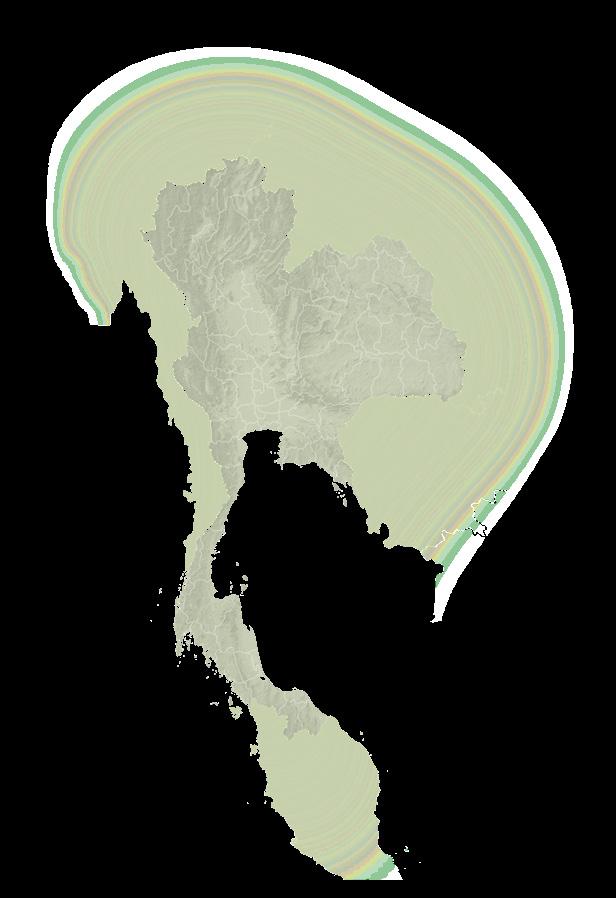

* All exploration results have been previously published in the following KCN Quarterly Reports: KCN Quarterly Report for the period ending 30 June 2025 published 31 July 2025, KCN Quarterly Report for the period ending 31 March 2025 published 30 April 2025, KCN Quarterly Report for the period ending 30 September 2024, published 30 October 2024















The area is divided into six zones including Main, Western, Northern, Northeastern and Southern zones and T Prospect. CSEC is interpreted as a peripheral component of the Chatree epithermal system. The main lithological units are: fiamme breccia, volcanogenic sediments, rhyolitic tuff, andesitic tuff and basal andesite. These units have been intruded by andesite, porphyritic andesite and feldspar porphyry dykes.
Gold mineralisation is found mainly within volcanogenic sediments and polymictic rhyolitic breccia and is associated with quartz-carbonate veins, containing 3 – 10% sulphide (mainly pyrite) in the form of clots, dissemination, and fracture fill. Supergene enrichment occurs in some areas up to 20 m below surface.
A total of 236 RC and 20 DD holes were drilled for 23,046 m RC and 2,608 m DD respectively during FY2025, exclusive of 9 geotechnical holes and 8 water bore holes.
Gold mineralisation is associated with silicified and phyllic-altered sedimentary rocks and rhyolitic breccias with some quartz veins and disseminated pyrite. Mineralisation at the main zone is trending NNW and shallow dipping (20 degrees) to the east, where fine-grained sediments are thicker and more fractured, either due to facies change and/or structural repetition (similar to Unit two at Chatree Gold Mine). The western boundary of mineralisation is relatively well defined and suggests that a controlling structure, such as a reverse fault, may be present at the base of mineralisation.
Drilling focused on infill holes designed to increase confidence in the along-strike and down-dip continuity of mineralisation zones.

Field reconnaissance





Chatree South East Complex Mineralisation Zone at 50mRL (>0.1 g/t Au)
Figure 2: Chatree South-East Complex area

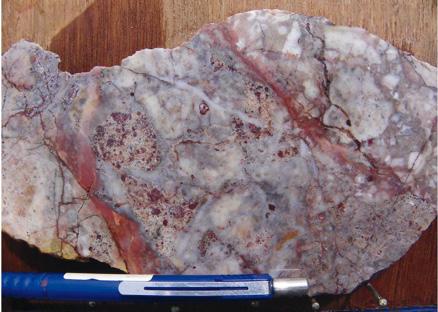
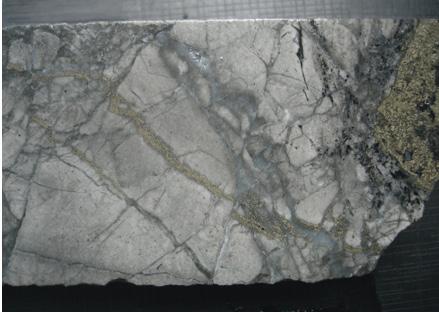
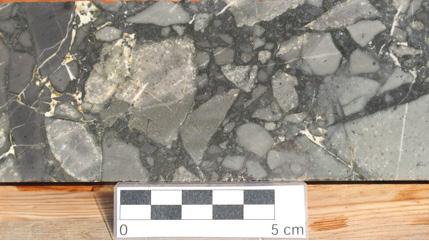
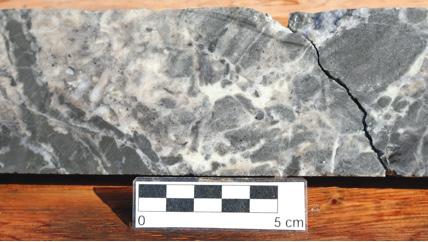
Northern zone
Mineralisation is mainly associated with phyllicaltered and silicified rhyolitic tuff and polymictic rhyolitic breccia, containing 1 – 5% quartz veins and 1 – 10% disseminated pyrite.
Northeastern zone
Drilling focused on infill lines to establish the continuity of gold mineralisation zones that were identified in 2024 and has confirmed that mineralisation extends from the Main zone toward the Northeast for >500 m. Gold mineralisation is mainly hosted within silicified/ phyllic altered polymictic rhyolitic breccia, rhyolitic tuff and sediments, containing trace to 10% quartz veins and 2 – 10% fine-grained disseminated pyrite.
Southern zone
Drilling results confirmed that gold mineralisation is generally associated with a silicified sedimentary unit, comprised of pale to dark grey siltstone and sedimentary breccia with small quartz stockwork veins and 5 – 10% disseminated pyrite.
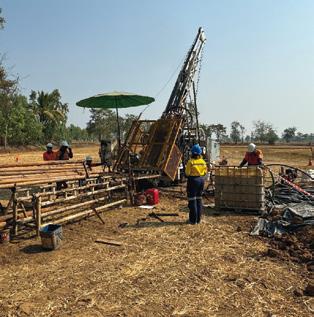
Diamond drilling at Chatree South-East Complex
Geology is predominantly andesitic (polymictic) tuff with locally intercalated rhyolitic tuff. Gold mineralisation is related to a sub-vertical zone of quartz veining, containing 3 – 5% pyrite within zones of phyllic-altered and silicified host rock.
Mineralisation extends from Chatree Mine D pit in a south-west direction.
Chatree South-East Complex Section 10485N
Figure 4: Section 10485N at Western zone, Chatree South-East Complex
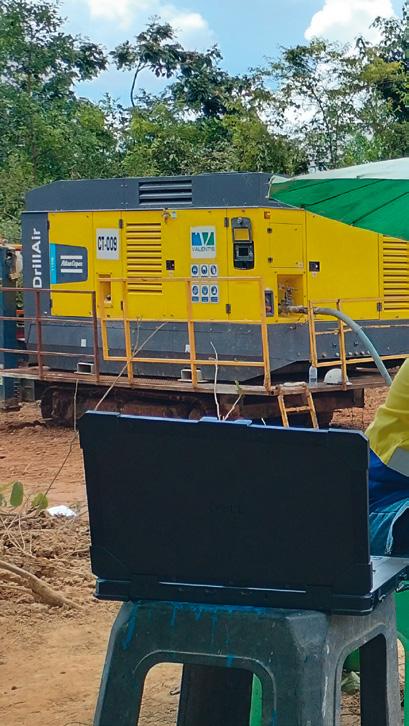
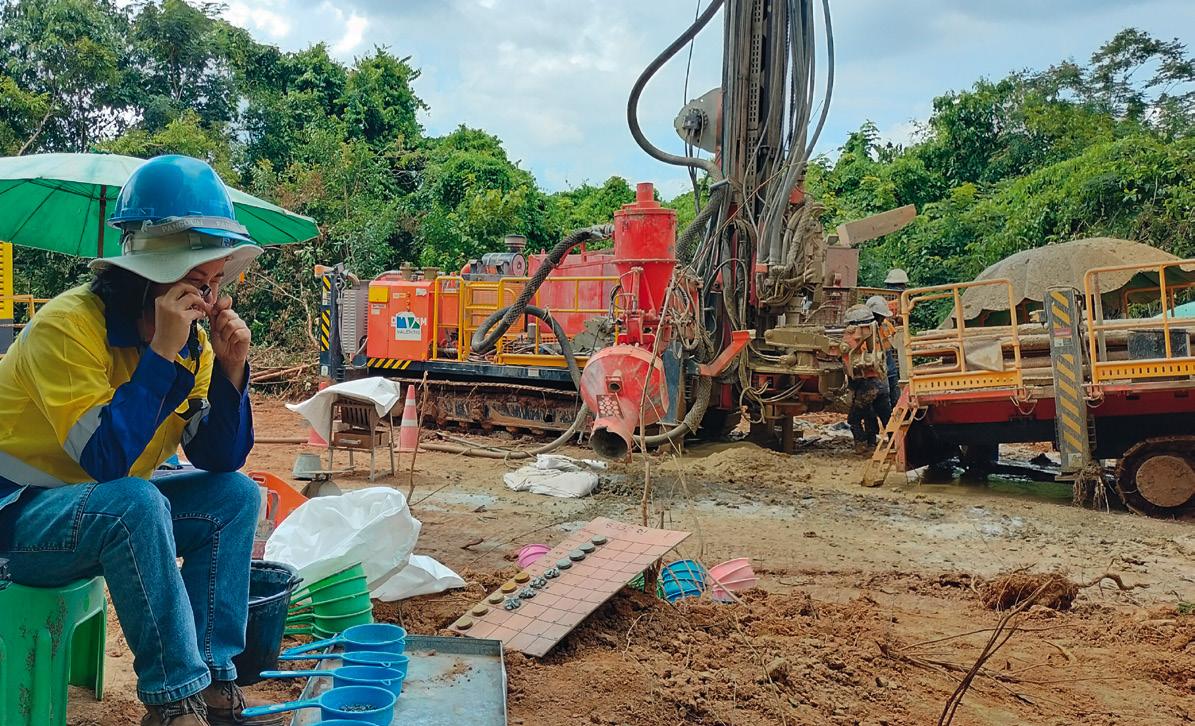
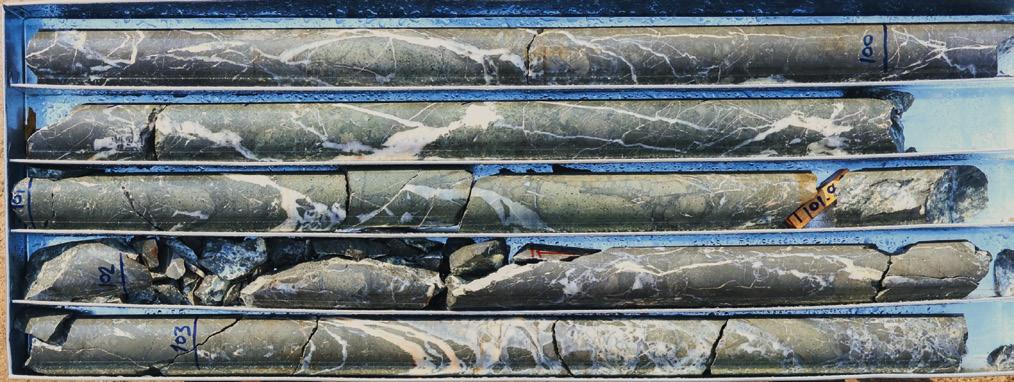
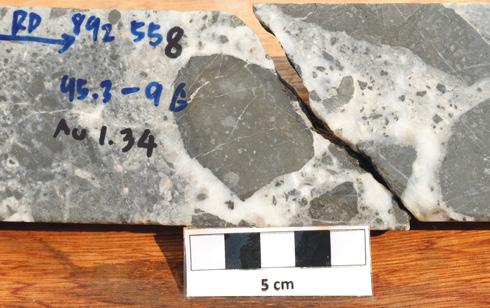
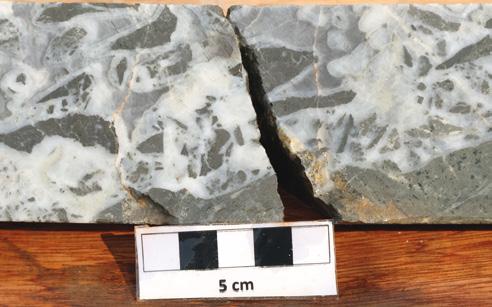
Drilling followed-up previous significant drilling intercepts in 2024. Several high-grade intercepts were identified in the Middle and Southern zones, characterised by quartz veins with disseminated pyrite and traces of chalcopyrite, galena and sphalerite.
A total of nine RC holes and one DD hole were drilled for 1,437 metres and 130 metres respectively during FY2025.
The prospect is underlain by andesitic tuff and polymictic andesitic breccia with minor rhyolitic tuff and fiamme breccia. Andesite and diorite occur as dykes or small stocks throughout the area. Gold mineralisation is related to massive-colloform banded quartz veins, with disseminated pyrite and trace chalcopyritegalena and sphalerite. These sub-parallel quartz-sulphide veins (0.5 – 6 m width) continue for 2.5 km along a NNW-SSE strike.
A second phase of deep diamond drilling was undertaken in the northern portion of a previously identified potassium anomaly where malachite staining has been observed in a remnant quarry and also in the east of the prospect where a magnetite-sulphide skarn was observed along the contact between diorite and limestone. The presence of quartz-base-metal veining indicates that these holes were drilled on the periphery of a porphyry system.
Chang Puek Prospect Section 1975N
Mineralisation Zone
Andesitic rock
Andesite dyke
Regolith
Clastic sediments
Limestone
Rhyolitic rock
Fault
>0.5 g/t Au >1.0 g/t Au >3.0 g/t Au
>0.3 g/t Au
Average Au grade intercept >0.1 g/t Au
5m@3.6 (122–127m)
10m@2.33 (137–147m)
4m@0.75 (105–109m)
13m@0.56 (137–150m)
3m@1.55 (165–168m)
3m@1.43 (150–153m)
8m@3.52 (158–166m)
3m@1.83 (177–180m)
3m@0.65 (202–205m)
(57–59m)
7m@1.55 (71–78m)
4m@0.82 (71–75m)
3m@0.60 (107–110m)
37m@2.90 (78–115m)
3m@1.07 (155–158m)
4m@0.61 (154–158m)
7m@1.76 (195–202m)
3m@1.87 (206–209m)
2m@0.65 (218–220m)
10m@0.99 (227–237m)
Nok Kaeo Prospect
(17–19m)
(28–34m)
Legend
Mineralisation Zone
Diorite dyke
Andesite dyke
Rhyolite dyke
Average Au grade intercept
>3.0 g/t Au
>1.0 g/t Au
>0.5 g/t Au
>0.2 g/t Au
<0.2 g/t Au
(21–24m)
(12–18m)
Section 7950N 9m@0.71 (75–84m)
(90–97m) 3m@0.59 (116–119m) 1m@19.30 (139–140m)
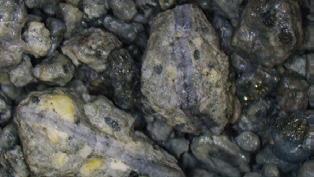
8288RC: 22 – 23m 1m@1.09 g/t Au
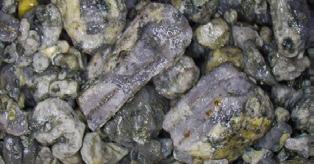
8288RC: 24– 25m 1m@4.86 g/t Au
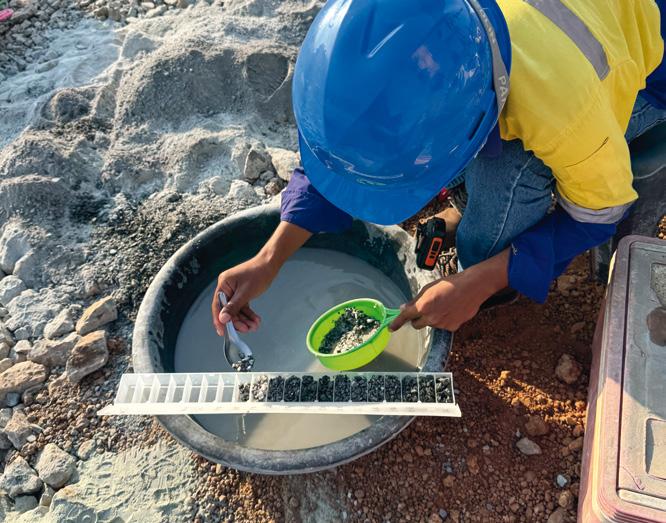
As at 30 June 2025, Mineral Resources, inclusive of Ore Reserves, were estimated to contain 3.6 million ounces of gold and 85.8 million ounces of silver.
This represents a decrease from 30 June 2024 of 16% gold and 25% silver due to mining depletion at Chatree, reporting within Reasonable Prospects for Eventual Economic Extraction (RPEEE) economic shells at US$2800 gold per oz and US$36 silver per oz, revised geological modelling, initial reporting of Chatree South-East Complex and estimation updates for both Chatree and Nueva Esperanza.
As at 30 June 2025, Ore Reserves were estimated to contain 1.5 million ounces of gold and 51 million ounces of silver. This
represents a decrease from 30 June 2024 of 6% gold and 16% silver due to mining depletion at Chatree, and revised input
assumptions and changes to underlying geological models.
Proved and Probable Reserves
Refer to the Ore Reserves table for detailed tonnage, grade and metal content categorised by confidence/classification.
Mineral Resources and Ore Reserves
Assurance processes and internal controls applied to verify the Mineral Resources and Ore Reserves estimates includes:
〉 Processes for public reporting aligned with ASX Listing Rules Chapter 5 (2019) and the Australasian Code for Reporting of Exploration Results, Mineral Resources and Ore Reserves, December 2012 (JORC Code);
〉 Independent assessment of new or materially changed estimates; and
〉 Reconciliation performance metrics to validate Chatree Ore Reserves.
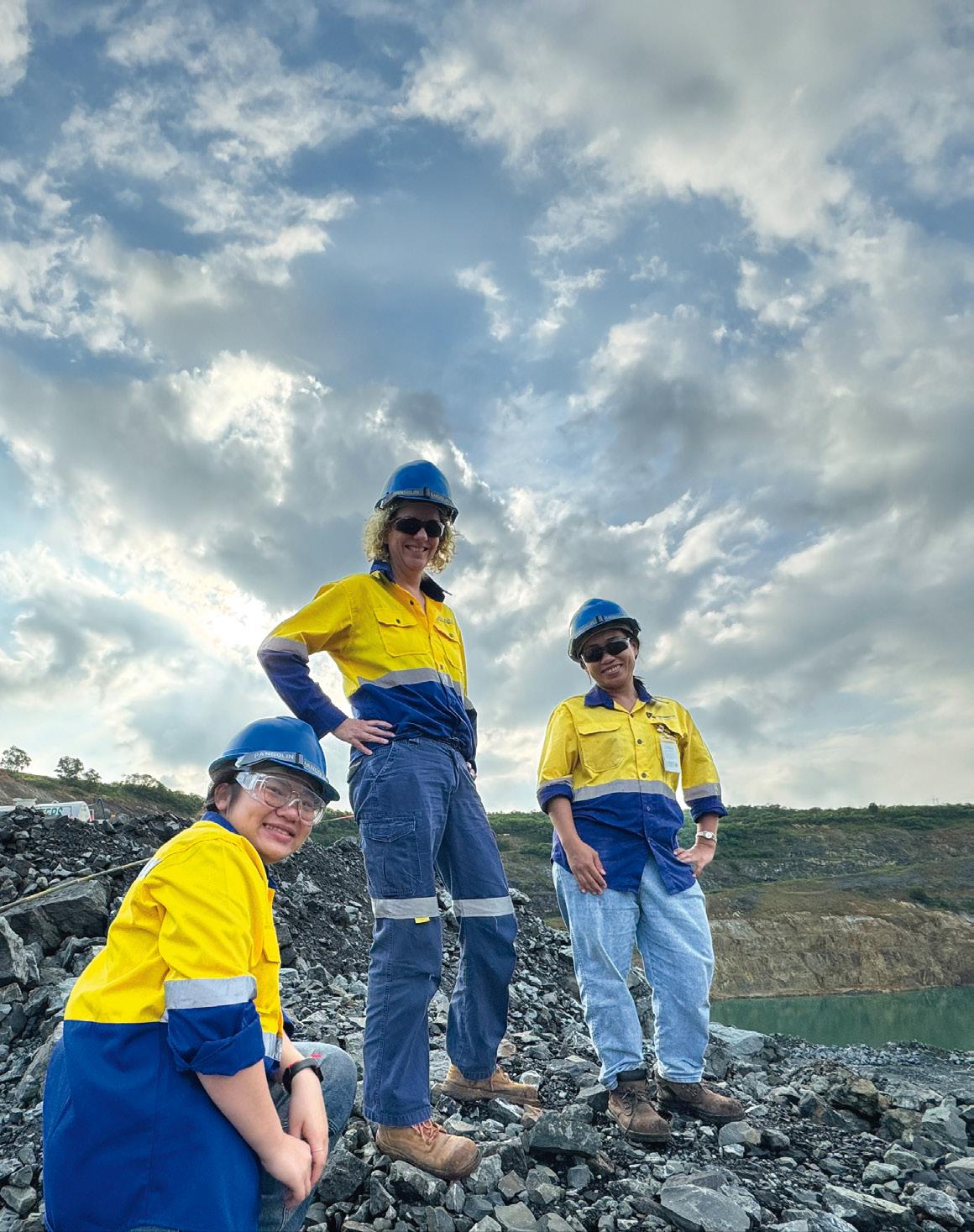
Endnotes to the Mineral Resources and Ore Reserves tables
1, 10 Reported on a 100% basis.
2, 11 Reported on a dry metric tonnes basis.
3, 9 All tabulated tonnes, grade and metal information has been rounded to two significant figures to reflect appropriate precision in the estimates and this may cause some apparent discrepancies in totals.
4, 14 Chatree metallurgical recoveries are 86.4% Au and 57.9% Ag based on metallurgical testwork and plant performance.
5, 6 Reported above a cut-off grade of 0.3 g/t Au within a RPEEE shell with assumed prices US$2800/oz Au and US$36/oz Ag.
7, 16 Nueva Esperanza metallurgical recoveries vary from 82% to 90% for gold and 71% to 88% for silver depending upon the deposit and the mineralogy.
8 Reported above cut-off criteria of Arqueros NSR$21 US$/t, Chimberos NSR$21 US$/t and Teterita 33 g/t Ag within a RPEEE shell with assumed prices US$2800/oz Au and US$36/oz Ag.
12 Ore delivered to processing facility.
13 Chatree Ore Reserves are reported above a break-even cut-off grade of NSR$16.16 using a gold price of US$1950/ oz and a silver price of US$26/oz.
15 There is no Ore Reserve estimate for South-East Complex.
17 Nueva Esperanza Ore Reserves are reported above a break-even cut-off grade of Arqueros NSR$21 US$/t, Chimberos NSR$21 US$/t and Teterita NSR$24.5 US$/t using a gold price of US$1950/oz and a silver price of US$26/oz.
Information relating to the Chatree Mineral Resource and Chatree South-East Complex Mineral Resource estimates is extracted from the ASX:KCN announcement Mineral Resources and Ore Reserves Statement October 2025 released on 10 October 2025 and is available to view on www.kingsgate.com.au. The Chatree Mineral Resource estimate has been depleted for mine production to 30 June 2025.
Information relating to Chatree Ore Reserves estimate is extracted from the ASX:KCN announcement Mineral Resources and Ore Reserves Statement October 2025 released on 10 October 2025 and is available to view on www.kingsgate.com.au. The Chatree Ore Reserves estimate has been depleted for mine production to 30 June 2025.
Information relating to Nueva Esperanza Mineral Resources and Ore Reserves estimates is extracted from the ASX:KCN announcement Mineral Resources and Ore Reserves Statement October 2025 released on 10 October 2025 and is available to view on www.kingsgate.com.au
The Company confirms that it is not aware of any new information or data that materially affects the information included in the original market announcements describing the Mineral Resources and Ore Reserves referenced above, and that all material assumptions and technical parameters underpinning the estimates in the relevant market announcement continue to apply and have not materially changed. The Company confirms that the form and context in which the Competent Person’s findings are presented have not been materially modified from the original market announcement.
The information in this Statement that relates to the Chatree Mineral Resource and Chatree South-East Complex Mineral Resource data provision and verification and Thailand exploration results is based on and fairly represents information and supporting documentation compiled by Jillian Terry, General Manager Geology and a full-time employee of the
Kingsgate Group, a Competent Person who is a Fellow of the Australasian Institute of Mining and Metallurgy. Ms Terry has sufficient experience that is relevant to the style of mineralisation and type of deposits under consideration, and to the activity being undertaken to qualify as a Competent Person as defined in the 2012 Edition of the Australasian Code for Reporting of Exploration Results, Mineral Resources and Ore Reserves. Ms Terry declares that she has no issues that could be perceived by investors as a material conflict of interest in preparing the reported information. Ms Terry has consented to the public reporting of these statements and the inclusion of the material in the form and context in which it appears.
The information in this Statement that relates to the Chatree Mineral Resource and Chatree South-East Complex Mineral Resource estimation is based on and fairly represents information and supporting documentation compiled by Michael Millad, Director, Principal Geologist/Geostatistician and a full-time employee of Cube Consulting, a Competent Person who is a Member of the Australian Institute of Geoscientists. Mr Millad has sufficient experience that is relevant to the style of mineralisation and type of deposit under consideration, and to the activity being undertaken to qualify as a Competent Person as defined in the 2012 Edition of the Australasian Code for Reporting of Exploration Results, Mineral Resources and Ore Reserves. Mr Millad declares that he has no issues that could be perceived by investors as a material conflict of interest in preparing the reported information. Mr Millad has consented to the public reporting of these statements and the inclusion of the material in the form and context in which it appears.
The information in this Statement that relates to the Chatree and Nueva Esperanza Ore Reserves estimates is based on and fairly represents information and supporting documentation compiled by Mitchell Rohr, Director of Mining
Engineering and a full-time employee of Cube Consulting, a Competent Person who is a Member of the Australasian Institute of Mining and Metallurgy. Mr Rohr has sufficient experience that is relevant to the style of mineralisation and type of deposit under consideration, and to the activity being undertaken to qualify as a Competent Person as defined in the 2012 Edition of the Australasian Code for Reporting of Exploration Results, Mineral Resources and Ore Reserves. Mr Rohr declares that he has no issues that could be perceived by investors as a material conflict of interest in preparing the reported information. Mr Rohr has consented to the public reporting of these statements and the inclusion of the material in the form and context in which it appears.
The information in this Statement that relates to the Nueva Esperanza Mineral Resource estimation is based on and fairly represents information and supporting documentation compiled by Paul Hetherington, Senior Resource Geologist and a full-time employee of Cube Consulting, a Competent Person who is a Member of the Australasian Institute of Mining and Metallurgy. Mr Hetherington has sufficient experience that is relevant to the style of mineralisation and type of deposit under consideration, and to the activity being undertaken to qualify as a Competent Person as defined in the 2012 Edition of the Australasian Code for Reporting of Exploration Results, Mineral Resources and Ore Reserves. Mr Hetherington declares that he has no issues that could be perceived by investors as a material conflict of interest in preparing the reported information. Mr Hetherington has consented to the public reporting of these statements and the inclusion of the material in the form and context in which it appears.
Your Directors present their report on the Group consisting of Kingsgate Consolidated Limited and the entities it controlled at the end of or during the year ended 30 June 2025.
The following persons were Directors of Kingsgate Consolidated Limited during the year ended 30 June 2025 and up to the date of this report.
Ross Smyth-Kirk OAM
Executive Chairman
Jamie Gibson
Managing Director and Chief Executive Officer
Nucharee Sailasuta
Non-Executive Director
Peter Warren
Non-Executive Director
Kingsgate is a gold and silver mining, development, and exploration company headquartered in Sydney, Australia, with a growing global footprint. The Company operates the Chatree Gold Mine in Thailand and is advancing the promising Nueva Esperanza Silver-Gold Project in Chile’s highly endowed Maricunga Belt, positioning Kingsgate for continued growth and value creation across multiple key jurisdictions.
〉 No interim dividend was declared for the half-year ended 31 December 2024 (31 December 2023: nil).
〉 No final dividend was declared for the year ended 30 June 2025 (30 June 2024: nil).
The 2025 financial year marked a major milestone for Kingsgate, with the Australian Securities Exchange (“ASX”) reclassifying the Company from an ‘exploration entity’ to a ‘mining producing entity’. This recognition coincided with a significant step-change in operations, as both Plant #1 and Plant #2 exceeded their nameplate throughput capacity during the December 2024 quarter. The year also saw the arrival of the final shipment of Caterpillar mining equipment (41 units in total), expanding the fleet to include twenty 777 haul trucks and two 6030 excavators. With this enhanced capability, Kingsgate is now well positioned to accelerate material movement and support the uplift in gold and silver production.
FY2025 saw tangible progress in mining the A Pit, with 14.8 million tonnes of material moved, including 4.5 million tonnes of ore and 10.3 million tonnes of waste, delivering a strip ratio of 2.3x. Activity was centred on A Pit North and A Pit West respectively, supported by additional minor waste stripping along the western boundary.
Primary ore was fed to the ROM Pad, while waste material was used for constructing TSF#2 lifts, and other key site infrastructure, with the remainder delivered to the waste dumps.
A major milestone was the completion of the TSF#2 Stage 7 lift in April 2025. During September 2025, hauling was underway to build embankments along the northern, southern, and western sections of TSF#2, with clay placement for the Stage 8 lift ready to begin once the wet season ends. These works continue to strengthen TSF#2 foundations for ongoing mining expansion and higher throughput in the years ahead.
As at 30 June 2025, ore stockpiles were 3.6 million tonnes at an average grade of 0.43 grams of gold per tonne, representing approximately 50,000 ounces of in situ gold. These stockpiles provide a strong buffer and flexibility to support consistent mill feed going forward.
The Chatree operation continued to deliver outstanding plant performance, with both processing plants working in tandem to provide flexibility and resilience. Combined throughput for the year reached 5.42 million tonnes, averaging 657 tonnes per hour with plant availability of 95.7% – an excellent result that underpins the strength of Chatree’s processing operations. Processed ore averaged 0.53 grams of gold per tonne and 6.2 grams of silver per tonne, with recoveries of 82.3% for gold and 58.2% for silver respectively.
Plant #1
Plant #1 achieved an annual throughput of 2.08 Mtpa for the year ended 30 June 2025. Over the period, 2.07 million dry tonnes were crushed at an average feed rate of 327 tonnes per hour, with crusher availability of 93.6%. Milling performance closely matched this, with 2.08 million dry tonnes processed at an average feed rate of 252 tonnes per hour and availability of 95.8%.
Lower milling throughput during the year was largely attributable to limitations with the SAG Mill# 1 gearbox. A new gearbox for SAG Mill #1 has been purpose built that will allow a higher and more consistent throughput and is expected to be installed shortly.
Plant #2 continued to deliver outstanding results, significantly outperforming its original 2.7 Mtpa design capacity. For the year ended 30 June 2025, throughput reached 3.34 Mtpa – a strong 24% above nameplate capacity. Average milling feed rate was 405 tonnes per hour with plant availability of 96%.
For the year ended 30 June 2025, Kingsgate delivered a strong production performance, producing 74,661 ounces of gold and 625,698 ounces of silver - a substantial increase on the prior year, and a clear reflection of the Company’s operational ramp-up and growing efficiency.
As at the date of this Directors’ Report, the arbitral award under the Thailand-Australia Free Trade Agreement (TAFTA) remains deferred by mutual agreement between Kingsgate and the Kingdom of Thailand, currently set for 30 September 2025. In light of recent developments in the Thai political landscape, Kingsgate is currently engaging with the new Thai Government and expects to provide an update on the TAFTA negotiations in due course.
Nueva Esperanza is a prefeasibility-stage development project, with updated Mineral Resource and Ore Reserve estimates scheduled for publication in October 2025. These estimates will be informed by a comprehensive review, validation, and modelling of all available drill and modifying factor data.
During the year ended 30 June 2025, Kingsgate continued to explore opportunities to advance the project. A geochemical sampling and
assessment program was conducted across prospective areas beyond the current resource footprint, and additional hydrogeological studies were initiated to support future development planning. A hydrogeological consultant and specialist legal counsel were also appointed during the year to ensure that the project remains in good stead.
Kingsgate continues to explore all options available to advance the project to unlock further value for shareholders including a separate listing of the asset in the North Americas, a joint venture or sale.
As at 30 June 2025, the Group’s total cash and bullion totalled $84.0 million comprising of the following:
〉 Unrestricted group cash of $23.8 million;
〉 Bullion in safe (unrefined gold and silver) of $31.4 million;
〉 Bullion receivables held at the Precious Metals Refining Company Limited (“PMR”) of $13.8 million and proceeds received in July 2025; and
〉 Restricted cash of $15.0 million relating predominantly to community and rehabilitation fund commitments.
During FY2025 Kingsgate was focused on maintaining strong liquidity during its initial ramp
up phase of operations and simplifying its funding structures by consolidating its existing debt.
In July 2024 Kingsgate entered into definitive loan documentation for a two tranche US$35 million loan facility (“Nebari Loan Facility”) with Nebari Gold Fund 1 LP (“NGF 1”) and Nebari Natural Resources Credit Fund II LP (“NNRCF II” and collectively, “Nebari”) with proceeds used to repay the NGF 1 bridge loan facility, repay the preference shareholder loan and provide the Kingsgate Group with additional capital to support mining operations at Chatree.
Refer to ASX:KCN release titled “Kingsgate Financing Update”, dated 16 July 2024 for further details of the Nebari Loan Facility.
Interest on the Nebari Loan Facility was capitalised until 31 December 2024 and principal repayments on tranche 1 commenced on 31 March 2025. As at 30 June 2025, the closing balance on the Loan Facility was $52.0m.
During the September 2024 quarter, Kingsgate made a THB 150 million principal repayment of the THB 300 million preference shareholder loan, and a further THB 150 million principal repayment was made during the December 2024 quarter. The preference shareholder loan has now been repaid in full.
Production summary
Production summary
Revenue summary
Kingsgate has recorded earnings before interest, tax and depreciation (EBITDA) of $94.5 million and net profit after income tax of $29.5 million for the year ended 30 June 2025. After adjusting for the non-cash $228 million impairment reversal recorded during FY2024, FY2025 EBITDA was up $109.4 million and net profit was up $58.4 million on the previous financial year.
Total gold production for FY2025 was 74,661 ounces of gold and 625,698 ounces of silver at an all-in-sustaining cost (AISC) of US$2,024 per ounce of gold sold.
As a mining company, we operate in a dynamic and complex environment where various factors and risks can impact our operations, financial performance, and sustainability. It is crucial for our stakeholders to be aware of these material business risks. While we strive to manage these risks effectively, there can be no assurance that they will not have a significant impact on our business in the future. The following are the material business risks that could affect our Group:
Access to capital for exploration, development, and expansion projects is essential for our growth. Financial market conditions, interest rates, and credit availability can influence our ability to raise funds. The Group’s ability to successfully develop projects is contingent on
the ability to fund those projects from operating cash flows or through affordable debt and equity raisings.
The Group’s activities are subject to the political, economic, social and other risks and uncertainties in the jurisdictions in which those activities are undertaken, including changes in government policies, local community relations, and potential disruptions due to protests or conflicts in the regions we operate in.
As evidenced by the decision by the Thai Government that the Chatree Gold Mine must cease operation by 31 December 2016, there can be no certainty as to what changes, if any, will be made to relevant laws in the jurisdictions where the Group has current interests, or other jurisdictions where the Group may have interest in the future, or the impact that relevant changes may have on the Group’s ability to own and operate its mining and related interests and conduct its business in those jurisdictions.
Commodity prices fluctuate according to changes in demand and supply. The Group is exposed to changes in commodity prices, which could affect the profitability of the Group’s projects. Significant adverse movements in
commodity prices could also affect the ability to raise debt and equity. The Group is also exposed to foreign exchange rate risk arising primarily with respect to the US dollar and Thai baht. Credit risk arises from cash and cash equivalents, deposits with banks and financial institutions, as well as credit exposures to refineries including outstanding receivables and committed transactions. The Group has no significant concentrations of credit risk. The Group’s liquidity requirements are based upon cash flow forecasts. Liquidity management, including debt/equity management, is carried out under policies approved by the Board and forecast material liquidity changes are discussed at Board meetings. Further detail on the Group’s market risk exposures is detailed in Note 28 to the Financial Statements.
Mineral Resources and Ore Reserves are estimates. These estimates are substantially based on interpretations of geological data obtained from drill holes and other sampling techniques. Actual mineralisation or geological conditions may be different from those predicted and as a consequence there is a risk that any part, or all of the Mineral Resources, will not be converted into Ore Reserves.
The fluctuations of the market price for gold and silver as well as increased production and capital costs, may render Ore Reserves unprofitable to develop at a particular site for periods of time.
These risks and hazards could result in significant costs or delays that could have a material adverse impact on the Group’s financial performance and position.
The Group maintains insurance to cover some of these risks and hazards at levels that are believed to be appropriate for the circumstances surrounding each identified risk. However, there remains the possibility that the level of insurance may not provide sufficient coverage for losses related to specific loss events.
The Group’s activities are subject to obtaining and maintaining the necessary titles, authorisations, permits and licences, and associated land access arrangements with the local community, which authorise those activities under the relevant law (“Authorisations”).
There can be no guarantee that the Group will be able to successfully obtain and maintain relevant Authorisations to support its activities, or that the renewal of existing Authorisations will be granted in a timely manner or on terms acceptable to the Group.
Authorisations held by or granted to the Group may also be subject to challenge by third parties which, if successful, could impact on the Group’s exploration, development and/or mining activities.
Some aspects of the Group’s activities are conducted by contractors. As a result, the Group’s business performance is impacted upon by the availability and performance of contractors and the associated risks.
We may face legal disputes related to the contractual agreements, environmental claims, or other matters that can result in financial losses and damage to our reputation.
The Group has established community relations functions that have developed a community engagement framework, including a set of principles, policies, and procedures designed to provide a structured and consistent approach to community activities.
A failure to appropriately manage local community stakeholder expectations may lead to damage to the Group’s reputation and disruptions in the Group’s activities.
Ensuring the health and safety of our employees is paramount. Health crises, such as pandemics can disrupt operations and pose risks to our workforce.
Mining operations inherently involve risks related to equipment failures, accidents and geological challenges. Ensuring the safety of our workforce and mitigating operational disruptions is a top priority.
Stringent and extensive environmental regulations govern our industry. Failure to comply with these regulations can lead to fines, legal liabilities, and reputational damage. Adapting to evolving environmental standards is crucial. Delays in obtaining, or failure to obtain government permits and approvals may adversely affect the Group.
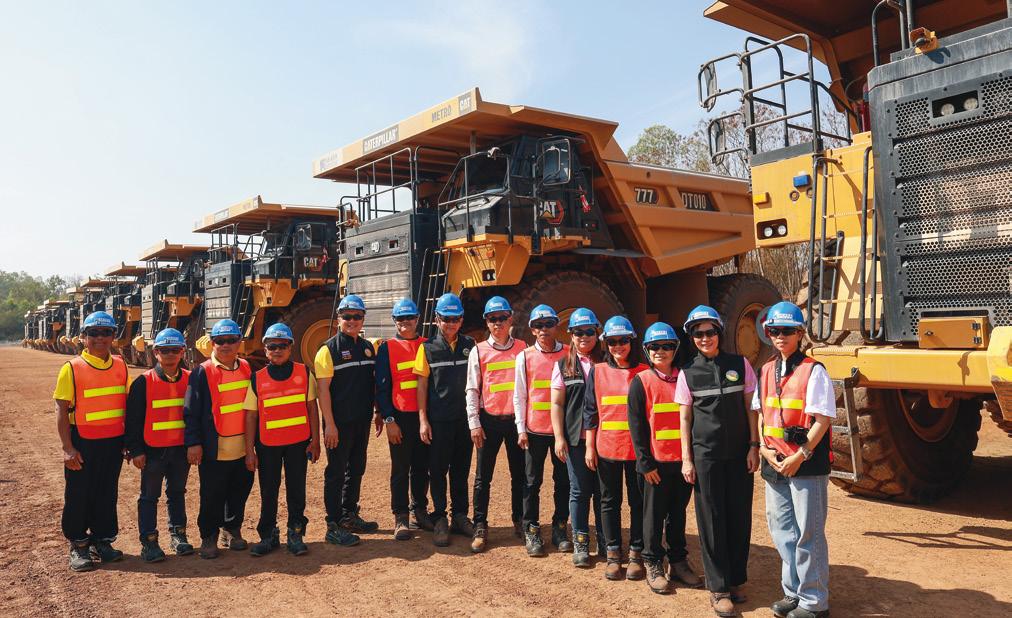
Climate change considerations, including carbon emissions and environmental sustainability, are increasingly important for our industry. Failure to address these issues can result in reputational harm and regulatory challenges.
It is essential to note that these risks are interconnected, and their impact may vary based on market conditions, industry trends, and other factors. We are committed to proactive risk management, continuous improvement, and transparency in our reporting to mitigate these material business risks and ensure the long-term success of our mining operations.
Please note that this list of material business risks is not exhaustive, and there may be other risks specific to our industry or individual circumstances that could affect our business. Our Board and management team regularly review and update our risk assessment to adapt to changing conditions and implement strategies for risk mitigation.
There were no other significant changes in the state of affairs of the Group that occurred during the financial year not otherwise disclosed in this report or the consolidated financial statements.
No matter or circumstance has arisen since 30 June 2025 that has significantly affected, or may significantly affect:
〉 the Group’s operations in future financial periods;
〉 the results of those operations in future financial periods; or
〉 the Group’s state of affairs in future financial periods.
Kingsgate is focused on building on FY2025’s gold production of 75 koz. FY2026 represents the first full year of mining and processing at both plants targeting throughput above the aggregate nameplate capacity.
As noted in Kingsgate’s Investor Presentation September 2025 (see ASX release dated 11 September 2025), FY2026 production guidance at Chatree is 85 – 95 koz of gold at an all in sustaining cost (“AISC”) pre-royalties of US$1,550 – US$1,750/oz. On a gold equivalent basis, the production guidance is 93 – 103 koz AuEq.
The year ahead represents a consolidation phase in Chatree’s Life of Mine Plan (“LOMP”) with a focus on greater waste tonne movements. In
FY2025, the average strip ratio was 2.3x and in FY2026 this is forecast to increase to 3.5x and the additional waste movements will improve future access to the ore body and support long-term production targets.
The Company continues to evaluate options to progress its Nueva Esperanza project in Chile with technical work underway on the reserves, environmental licences/permits, and water well testing. Options to monetise the asset through a sale process, separate listing or otherwise remain under consideration.
Kingsgate will also continue to assess, other viable gold and precious metal project opportunities which may offer value enhancing opportunities for shareholders.
Material business risks that may impact the results of future operations include tenure risks, environmental risks, ore reserve and mineral resource estimates, production estimates and metallurgical recovery, sovereign risks, debt funding risks, future commodity prices, exchange rate risks, development risks, reliance on key personnel, operating risks, capital costs, operating costs, occupational health and safety, political and regulatory risks.
The Group is subject to various environmental laws in respect to its activities in Thailand and Chile. For the year ended 30 June 2025, the Group has operated within all applicable environmental laws and regulations.
A Number of meetings attended.
B Number of meetings held during the time the Director held office or was a member of the committee during the year.
Ross Smyth-Kirk OAM B Com, CPA, F Fin
Executive Chairman
Mr Smyth-Kirk was a founding director of the former leading investment management company, Clayton Robard Management Limited and has had extensive experience in investment management across the minerals and mining sectors. Mr Smyth-Kirk has been a director of a number of companies over the past 45 years in both Australia and the United Kingdom and was previously Chairman of the Australia Jockey Club Limited. He is Chairman of Kingsgate’s subsidiary, Akara Resources Public Company Limited.
Mr Smyth-Kirk is a CPA, a Fellow of the Financial Services Institute of Australasia (FINSIA) and holds a Bachelor of Commerce degree from the University of New South Wales.
Responsibilities
Chairman of the Board, member of the Audit, Nomination and Remuneration Committees.
Jamie Gibson MBA, GAICD, GradCertGlobalBusPrac, DipMgt
Managing Director and Chief Executive Officer
Mr Gibson is the Managing Director and Chief Executive Officer of Kingsgate Consolidated Limited. Since joining the company in 2013, he has been instrumental in shaping corporate strategy, managing investor relations, and successfully restarting the Chatree Gold Mine.
An accomplished corporate professional, Mr Gibson has previously worked in government as a Chief Advisor in the mining portfolios (metals and coal) with extensive trade and investment expertise within the Asia-Pacific region. He is a Director of Akara Resources Public Company and made significant contributions when he served as a Board Member and Vice President of the Australia Thailand Business Council.
Mr Gibson holds a Master of Business Administration and a Graduate Certificate in Global Business Practice from Macquarie University, as well as a Diploma of Management from the Sydney Institute of Technology. He is also a graduate of the Australian Institute of Company Directors.
Responsibilities
Member of the Audit, Nomination and Remuneration Committees.
Nucharee Sailasuta MA/Ph.D of TPS
Non-Executive Director
Mrs Sailasuta is the Chairman and co-founder of LotusHall Mining Heavy Engineering Construction Company Limited, Chairman of Lotus Green Energy Company Limited, and the owner of Pangluang Garden Resort & Restaurant in Thailand. LotusHall Mining has been the mining contractor at the Chatree Gold Mine since exploration in 1999 and operations commenced in 2001.
Over her 41-year career, Mrs Sailasuta has worked across gold, copper, quarry, coal, kaolin and limestone mining operations, both in Thailand and within the neighbouring region, including the Sepon Gold/Copper Mine and Phubia Mining in Laos.
Mrs Sailasuta holds a combined Master’s and Doctoral degree in Trade and Political Management from the Faculty of Business Administration, Krirk University.
Mrs Sailasuta was successfully awarded the FGD No. 4 Project through the bidding in partnership with EGAT (Electricity Generating Authority of Thailand). She is the President of the Businesswoman’s Association of Lampang and works as a conciliator of Alternative Dispute Resolution for Lampang Court, Thailand. She was recently awarded “Outstanding Executive Working Woman” by the Lampang Chamber of Commerce.
Peter Warren B Com, CPA
Non-Executive Director
Mr Warren is a highly experienced mining professional and was Kingsgate’s Chief Financial Officer and Company Secretary for six years until his retirement in 2011. He was previously Chief Financial Officer and Company Secretary for Equatorial Mining Limited and of the Australian subsidiaries of the Swiss-based Alusuisse Group. Mr Warren has also held various financial and accounting positions for Peabody Resources and Hamersley Iron and is former Director of Kingsgate’s subsidiary, Akara Resources Public Company Limited.
Mr Warren is a CPA and holds a Bachelor of Commerce degree.
Responsibilities
Chairman of the Audit, Nomination and Remuneration Committees.
Stephanie Wen GAICD, LLB, B Com, MIA
General Counsel and Company Secretary
Ms Wen is a seasoned legal professional with broad experience across corporate transactions, general commercial legal advisory, regulatory implementation and governance. She has practised corporate law at both top-tier and mid-tier law firms in Asia and Australia and held senior in-house legal counsel role in global financial institutions. Ms Wen previously served as a non-executive director for an ASX-listed healthcare company.
Ms Wen holds a dual degree in Law and Commerce (LLB, B.Com in Accounting) from the University of New South Wales, and a Master of International Affairs (International Business and Finance) from Colombia University in New York. Additionally, she is a graduate of the Australian Institute of Company Directors and a Fellow of the Governance Institute of Australia.
This Remuneration Report forms part of the Directors’ Report. It outlines the Remuneration Policy and framework applied by the Company as well as details of the remuneration paid to Key Management Personnel (“KMP”). KMP are defined as those persons having the authority and responsibility for planning, directing and controlling the activities of the Company, directly or indirectly, including Directors and executive management. For FY25, the Company’s KMP consists of the Executive Directors (including the CEO) and the Chief Financial Officer (CFO).
The information provided in this report has been prepared in accordance with s300A and audited as required by section 308(3C) of the Corporations Act 2001
The objective of the Company’s remuneration philosophy is to ensure that Directors and Executives are remunerated fairly and responsibly at a level that is competitive, reasonable and appropriate for the size of the Company, in order to attract and retain suitably skilled and experienced people.
This Remuneration Policy has been designed to align the interests of shareholders, Directors, employees and other Company stakeholders. This is achieved by setting a framework to:
〉 help ensure an applicable balance of fixed and at-risk remuneration, with the at-risk component linking incentive and performance measures to both Group and individual performance;
〉 provide an appropriate and competitive reward for Directors and executive management to manage and lead the business successfully and to drive strong, long-term growth in line with the Company’s strategy and business objectives;
〉 facilitate transparency and fairness in Directors and Executive remuneration policy and practices;
〉 contribute to attraction, motivation and retention of highly skilled Directors and Executives; and
〉 avoid adverse community and investor perception and have regard to the Company’s commercial interest in controlling expenses by avoiding excessive pay to KMP.
In consultation with external remuneration consultants, the Group has structured a Directors and executive management remuneration framework that is market competitive and aligned with the operating model and business strategy of the organisation.
The framework is intended to provide a mix of fixed and variable remuneration, with a blend of short and long-term incentives as appropriate.
The Remuneration Committee is a committee of the Board and has responsibility for setting policy for determining the nature and number of emoluments of Board members and Executives. The Committee makes recommendations to the Board concerning:
〉 Non-Executive Director fees;
〉 remuneration level of Executive Directors and other KMP;
〉 the executive remuneration framework and operation of the incentive plan;
〉 key performance indicators and performance hurdles for the executive team; and
〉 the engagement of specialist external consultants to design or validate methodology used by the Company to remunerate Directors, senior executives.
The Remuneration Committee Charter is in the Company’s Corporate Governance materials and may be viewed on its website at www.kingsgate.com.au/governance
The Group engages the services of independent and specialist remuneration consultants from time to time. Under the Corporations Act 2001, remuneration consultants must be engaged by the Non-Executive Directors and reporting of any remuneration recommendations in respect of KMP must be made directly to and approved by the Remuneration Committee. The remuneration recommendation must be accompanied by a declaration from the remuneration consultant that it was free from undue influence of the member or members of the KMP to whom the recommendation relates.
During the year, the Godfrey Remuneration Group (GRG) was appointed to advise the Remuneration Committee on the Company’s remuneration framework and policies for senior executives (including the MD & CEO). GRG
provided ‘remuneration recommendations’ (as defined under the Corporations Act 2001) and a declaration that the remuneration recommendations were made free from undue influence by the individual KMP to whom the recommendation relates to. GRG recommendations included pay recommendations, implementation of variable remuneration policy and equity incentive plans for senior executives. The Board has considered GRG’s engagement process and its declaration of no undue influence, and is satisfied that the remuneration recommendations received from GRG were made free from undue influence by any member of the KMP to whom the recommendations related. Fees paid to GRG were $78,430.
The Executive pay and reward framework is comprised of three components:
〉 fixed remuneration including superannuation;
〉 short-term performance incentives; and
〉 long-term incentives.
Total fixed remuneration (“TFR”) is structured as a total employment cost package, including base pay and superannuation. Base pay may be delivered as a mix of cash, statutory and salary sacrificed superannuation, and prescribed non-financial benefits at the Executive’s discretion.
Executives are offered a competitive base pay based on benchmarking of equivalent roles. Base pay for executives is reviewed annually to ensure their pay is competitive with the market. An Executive’s pay is also reviewed on promotion.
The following table summarises the performance of the Group over the last five years:
* see page 38 for table outlining the short-term employee benefits.
Linking current financial year earnings of executives to their performance and the performance of the Group is the key objective of our Short-Term Incentive (“STI”) Plan. The Remuneration Committee sets key performance measures and indicators for the individual executives on an annual basis that reinforce the Group’s business plan and targets for the year.
The Board has discretion to issue cash bonuses to employees for individual performance outside the STI Plan.
The structure of the STI Plan remains unchanged since 30 June 2016 and its key features are outlined in the table below. The STI Plan did not operate during FY25 and does not currently apply to any current executives. Following the restart of the operations at Chatree, the Remuneration Committee is reviewing the Group’s remuneration structure with independent remuneration consultants to align it with market norms and investor expectation for FY26.
What is the STI Plan and who participates?
How much can the executives earn under the STI Plan?
Is there Board discretion in the payment of an STI benefit?
What are the performance conditions?
The STI Plan is a potential annual reward for eligible Executive Key Management Personnel for achievement of predetermined individual Key Performance indicators (“KPIs”) aligned to the achievement of business objectives for the assessment period (financial year commencing 1 July).
Threshold – represents the minimum acceptable level of performance that needs to be achieved before any Individual Award would be payable in relation to that Performance Measure.
Managing Director/CEO – up to 15% of TFR.
CFO – up to 12.5% of TFR.
Other Executive KMP – up to 10% of TFR.
Target – represents a challenging but achievable level of performance relative to past and otherwise expected achievements. It will normally be the budget level for financial and other quantitative performance objectives.
Managing Director/CEO – up to 30% of TFR.
CFO – up to 25% of TFR.
Other Executive KMP – up to 20% of TFR.
Stretch (Maximum) – represents a clearly outstanding level of performance which is evident to all as a very high level of achievement.
Managing Director/CEO – up to 60% of TFR.
CFO – up to 50% of TFR.
Other Executive KMP – up to 40% of TFR
(TFR – Total Fixed Remuneration)
Yes, the plan provides for Board discretion in the approval of STI outcomes.
For Executive KMP, between 70 – 80% of potential STI weighting (dependent upon role) is assessed against specific predetermined KPIs by role with 20 – 30% being based on company performance indicators.
How are performance targets set and assessed?
Individual performance targets are set by the identification of key achievements required by role in order to meet business objectives determined for the upcoming assessment period in advance. The criteria for Executive KMP are recommended by the Managing Director/CEO for sign off by the Remuneration Committee and in the case of the Managing Director/CEO, are recommended by the Chairman by sign off by the Remuneration Committee.
The relative achievement at the end of the financial period is determined by the above authorities with final sign off by the Remuneration Committee after confirmation of financial results and individual/ company performance against established criteria.
The Remuneration Committee is responsible for assessing whether the KPIs are met. To assist in this assessment, the Committee receives detailed reports on performance from management which are verified by independent remuneration consultants if required. The Committee has the discretion to adjust STIs in light of unexpected or unintended circumstances.
How is STI delivered? STIs are paid in cash after the conclusion of the assessment period and confirmation of financial results/individual performance and subject to tax in accordance with prevailing Australian taxation laws. The STIs are then in effect paid and expensed in the financial year subsequent to the measurement year.
What happens in the event of cessation of employment?
Executives are required to be employed for the full 12 months of the assessment period before they are eligible to be considered to receive benefits from the STI Plan.
The objectives of the Long-Term Incentive (“LTI”) Plan are to retain key executives and to align an at-risk component of certain executives’ remuneration with shareholder returns.
It is the Company’s policy to establish remuneration structures which can clawback or otherwise limit performance-based outcomes after award payment or vesting in circumstances where expected outcomes are not achieved or outcomes are deleterious to the Company.
Under the terms of the Kingsgate Employee Share Plan (ESOP) long-term incentives can be provided to certain employees through the issue of options to acquire Kingsgate shares. Options are issued to employees to provide incentives for employees to deliver long-term shareholder returns.
Key features of the ESOP LTI Plan are outlined in the following table. The LTI Plan was not in operation in FY25 and does not currently apply to any current executives. Following the restart of the operations at Chatree, the Remuneration Committee has reviewed its remuneration structure with independent remuneration consultants to align it with market norms and investor expectation.
What is the LTI Plan and who participates?
What are the performance and vesting conditions?
Is there a cost to participate?
What happens in the event of bonus shares, rights issues, or other capital reconstructions?
Kingsgate executives and other eligible employees can be granted options to acquire Kingsgate Consolidated Limited fully paid shares. In granting the options the Board takes into account such matters as the position of the eligible person, the role they play in the Company, their current level of fixed remuneration, the nature of the terms of employment and the contribution they make to the Group.
The period over which the options vest is at the discretion of the Board though in general it is 1-3 years. The executive and eligible employee must still be employed by the Company at vesting date.
The options may at the discretion of the Board be issued for nil consideration and are granted in accordance with performance guidelines established by the Remuneration Committee and approved by the Board.
If between the grant date and the date of conversion of options into shares there are bonus shares, rights issues or other capital reconstructions that affect the value of Kingsgate Consolidated shares, the Board may, subject to the ASX Listing Rules make adjustments to the number of rights and/or the vesting entitlements to ensure that holders of rights are neither advantaged or disadvantaged by those changes.
The named Directors held their current position for the whole of FY25 and up to the date of this report.
Ross Smyth-Kirk OAM
Jamie Gibson
Nucharee Sailasuta
Peter Warren Executive Chairman
Director and Chief Executive Officer
Daniel O’Connell was appointed Chief Financial Officer on 29 July 2024 and was an Executive KMP during FY25. He stepped down as CFO on 3 February 2025 and accordingly ceased to be an Executive KMP from close of business on 3 February 2025.
As at the report date, since the end of the Reporting Period, there were no other changes other than the appointment of Mischa Mutavdzic as the Chief Financial Officer of Kingsgate on 17 July 2025. Mr Mutavdzic is an Executive KMP for FY26. Please see the ASX Announcement ‘Corporate Update’ on 17 July 2025 for more details.
Remuneration and other key terms of employment for the Executive KMPs during FY25 are summarised in the following table:
1 Amount shown are annual salaries as at year end. This amount does not include the director fees received from subsidiary.
2 Notice period by the Company in respect of benefits payable in the event of an early termination.
3 Jamie Gibson became an Executive Director on 3 February 2023 and was remunerated pursuant to the terms and conditions of a Consultancy Agreement entered into between Mr Gibson and the Company. Pursuant to the Agreement and subsequent amendment, Mr Gibson is entitled to a payment of up to $50,000 per month (inclusive of all entitlements) or as otherwise approved by Kingsgate, in respect of work performed for the Company. The Agreement may be terminated by either party by giving of 90 days notice, or earlier in the event of default not remedied within 14 days.
4 Daniel O’Connell was appointed Chief Financial Officer on 29 July 2024 (ASX Announcement ‘Corporate Update’, 22 July 2024) and ceased employment with the Company effective on the close of 3 February 2025 (ASX Announcement ‘Corporate Update’, 4 February 2025).
Fixed annual remuneration, inclusive of the required superannuation contribution amount is reviewed annually by the Board following the end of the financial year.
Non-Executive Directors are paid fixed fees for their services to the Company plus statutory superannuation contributions the Company is required by law to make on their behalf. Those fees are inclusive of any salary-sacrificed contribution to superannuation that a Non-Executive Director wishes to make.
The level of Non-Executive Directors’ fees is set so as to attract the best candidates for the Board while maintaining a level commensurate with boards of similar size and type. The Board may also seek the advice of independent remuneration consultants, including survey data, to ensure Non-Executive Directors’ fees and payments are consistent with the current market.
The Company does not give performance-based remuneration or retirement benefits to Non-Executive Directors.
The maximum total remuneration for Non-Executive Directors is determined by resolution of shareholders and is currently set at $1,000,000 in aggregate.
Non-Executive Directors’ base fees, inclusive of committee membership but not including statutory superannuation, are outlined as follows:
1 On an annualised basis for all Non-Executive Directors. This amount does not include director fees received from subsidiary. Each Non-Executive Director received an annualised base fee of $90,000.
The aggregate remuneration of Non-Executive Directors is set by shareholders in general meeting in accordance with the Constitution of the Company, with individual Non-Executive Directors’ remuneration determined by the Board within the aggregate total.
Non-Executive Directors do not receive any additional fees for serving on committees of the Company.
There are no retirement allowances for Non-Executive Directors.
Details of remuneration
Details of the nature and amount of each major element of the remuneration of the Directors and the Group Key Management Personnel are set out in the following tables:
June 2025
KMP
1 Non-monetary benefit related to car park space.
2 Represents annual leave (short-term) and long service leave (long-term) entitlements measured on an accrual basis and reflects the leave expenses over the 12 month period.
3 The Company retained Peter Warren Consulting Pty Limited on a 3 month contract following the cessation of Daniel O’Connell as CFO. The service scope includes reviewing and improving the Company’s financial systems and accounting structures, implementing recommended changes, and supporting the incoming CFO to ensure a smooth transition before FY2025 year-end.
4 Daniel O’Connell ceased employment with the Company effective on the close of 3 February 2025, (ASX Announcement ‘Corporate Update’ on 4 February 2025).
Sub-total Executive Directors
1 Non-monetary benefit relates to car parking.
2 Represents annual leave (short-term) and long service leave (long-term) entitlements measured on an accrual basis and reflects the leave expenses over the 12 month period.
3 Consulting fee related to assisting Kingsgate in managing its finances following the retirement of Kingsgate’s previous Chief Financial Officer earlier in the year while the Company continues to ramp up operational capacity at the Chatree Gold Mine, assisting the Acting Chief Financial Officer in the day-to-day capital management of Kingsgate, assisting with the preparation of statutory financial documents, and in particular working with various debt providers (lenders) to secure an additional debt facility for Kingsgate to provide ongoing working capital and liquidity.
The relative proportions of remuneration that are linked to performance and those that are fixed are as follows:
Executive Directors
Ross Smyth-Kirk
Jamie Gibson1
Other KMP
Daniel O’Connell
1 Jamie Gibson became an Executive Director on 3 February 2023 and was remunerated pursuant to the terms and conditions of a Consultancy Agreement entered into between Mr Gibson and the Company. Pursuant to the Consultancy Agreement and subsequent amendment, Mr Gibson is entitled to a payment of up to $50,000 per month (inclusive of all entitlements) or as otherwise approved by Kingsgate, in respect of work performed for the Company.
Shareholdings for Directors
Executive Chairman
Ross Smyth-Kirk
Executive Director
Jamie Gibson
Non-Executive Directors
Nucharee Sailasuta
Peter Warren
1 Jamie Gibson purchased 28,000 shares on-market on 8 October 2024.
2 Peter Warren purchased 40,000 shares on-market on 19 September 2024.
Loans to Directors
There were no loans made to Directors or other Key Management Personnel at any time during the year.
Insurance of officers
During the financial year, the Group paid premiums to insure Directors and Officers of the Group. The contracts include a prohibition on disclosure of the premium paid and nature of the liabilities covered under the policy.
Directors’ interest in contracts
a. Advances from preference shareholder (see Note 23d)
Mrs Nucharee Sailasuta advanced a total of 300,000,000 Thai baht as working capital support to Akara during the year ended 30 June 2023. The advance balance of 300,000,000 Thai baht was fully repaid during the year. A total of $309,000 interest was expensed.
b. Preference shares in controlled entity (see Note 16a and Note 23d) Preference shareholder interest in the amount of $1,447,000 were expensed during the year and an amount of $374,000 accrued at year end.
c. Services provided to Chatree Gold Mine (see Note 23d)
LotusHall Mining Heavy Engineering Construction Company Limited (LotusHall), of which Mrs Nucharee Sailasuta is the Chairman and co-founder, provided mining related services to Chatree Gold Mine during the year ended 30 June 2025. A total of $23,586,000 was recorded for services received from LotusHall during the year. At year end, $3,804,000 was included in current payables at which $1,991,000 was included in accounts payable and $1,813,000 was accrued.
d. Consulting contract with Peter Warren Consulting Pty Limited
During FY2025, the Company entered into a related party transaction with Peter Warren Consulting Pty Limited (“Peter Warren Consulting”), an entity wholly owned by Peter Warren, a Non-Executive Director of the Company. The Company engaged Peter Warren Consulting under a three-month consulting agreement following the cessation of Daniel O’Connell as Chief Financial Officer. The scope of services included reviewing and enhancing the Company’s financial systems and accounting structures, implementing recommended changes, and supporting the transition of responsibilities to the incoming CFO ahead of the FY2025 year-end. Fees paid under the consulting agreement totalled $76,000 during FY2025.
Details of amounts paid or payable to the auditor for non-audit services provided during the year are detailed in Note 29: Auditors’ Remuneration. The Directors are satisfied that the provision of non-audit services during the period by the auditor is compatible with the general standard of independence for auditors imposed by the Corporations Act 2001.
The Directors are of the opinion that the services disclosed in Note 29: Auditors’ Remuneration to the financial statements do not compromise the external auditors’ independence, based on the Auditors’ representations and advice received from the Audit Committee, for the following reasons:
〉 all non-audit services have been reviewed to ensure they do not impact the integrity and objectivity of the auditor; and
〉 none of the services undermine the general principles relating to auditor independence as set out in Code of Conduct APES 110 Code of Ethics for Professional Accountants issued by the Accounting Professional and Ethical Standards Board, including reviewing or auditing the auditor’s own work, acting in a management or decision-making capacity for the Company, acting as advocate for the Company or jointly sharing economic risks and rewards.
A copy of the Auditor’s Independence Declaration as required under section 307c of the Corporations Act 2001 is set out on page 42.
The Company is of a kind referred to in ASIC Corporations (Rounding in Financial Directors’ Reports) Instrument 2016/191 and in accordance with that instrument, amounts in the Directors’ Report have been rounded to the nearest thousand dollars except where otherwise indicated.
PricewaterhouseCoopers continues in office in accordance with section 327 of the Corporations Act 2001
This report is made in accordance with a resolution of Directors.

Ross Smyth-Kirk OAM Director
Sydney 30 September 2025
Auditor’s Independence Declaration

As lead auditor for the audit of Kingsgate Consolidated Limited for the year ended 30 June 2025, I declare that to the best of my knowledge and belief, there have been:
As lead auditor for the audit of Kingsgate Consolidated Limited for the year ended 30 June 2025, I declare that to the best of my knowledge and belief, there have been:
a. no contraventions of the auditor independence requirements of the Corporations Act 2001 in relation to the audit; and
a. no contraventions of the auditor independence requirements of the Corporations Act 2001 in relation to the audit; and
b. no contraventions of any applicable code of professional conduct in relation to the audit.
b. no contraventions of any applicable code of professional conduct in relation to the audit.
This declaration is in respect of Kingsgate Consolidated Limited and the entities it controlled during the period.
This declaration is in respect of Kingsgate Consolidated Limited and the entities it controlled during the period.


Craig Thomason
Sydney
Craig Thomason
Partner
Partner
PricewaterhouseCoopers
PricewaterhouseCoopers
pwc.com.au
pwc.com.au
www.kingsgate.com.au
PricewaterhouseCoopers, ABN 52 780 433 757
30 September 2025
Sydney
30 September 2025
PricewaterhouseCoopers, ABN 52 780 433 757 One International Towers Sydney, Watermans Quay, BARANGAROO NSW 2000, GPO BOX 2650, SYDNEY NSW 2001
T: +61 2 8266 0000, F: +61 2 8266 9999, www.pwc.com.au
One International Towers Sydney, Watermans Quay, BARANGAROO NSW 2000, GPO BOX 2650, SYDNEY NSW 2001
T: +61 2 8266 0000, F: +61 2 8266 9999, www.pwc.com.au
Level 11, 1PSQ, 169 Macquarie Street, PARRAMATTA NSW 2150, PO Box 1155 PARRAMATTA NSW 2124
T: +61 2 9659 2476, F: +61 2 8266 9999, www.pwc.com.au
Level 11, 1PSQ, 169 Macquarie Street, PARRAMATTA NSW 2150, PO Box 1155 PARRAMATTA NSW 2124
T: +61 2 9659 2476, F: +61 2 8266 9999, www.pwc.com.au
Liability limited by a scheme approved under Professional Standards Legislation.
Liability limited by a scheme approved under Professional Standards Legislation.

For the year ended 30 June 2025
As at 30 June 2025
The above consolidated statement of financial position should be read in conjunction with the accompanying notes.
For the year ended 30 June 2025
The above consolidated statement of changes in equity should be read in conjunction with the accompanying notes.
For the year ended 30 June 2025
As at 30 June 2025
* Trustee of the Company under Executive Share Plan
The ordinary share class constitutes 48% of issued capital of Akara
The Financial Report of Kingsgate Consolidated Limited (Kingsgate or the “Company”) for the year ended 30 June 2025 was authorised for issue in accordance with a resolution of Directors on 29 September 2025.
Kingsgate is a company limited by shares incorporated in Australia whose shares are publicly traded on the Australian Securities Exchange using the ASX code KCN. The consolidated financial statements of the Company as at and for the year ended 30 June 2025 comprise the Company and its subsidiaries (together referred to as the “Group” and individually as “Group entities”).
A description of the nature of the Group’s operations and its principal activities is included in the Directors’ Report.
These general purpose financial statements have been prepared in accordance with the Australian Accounting Standards, other authoritative pronouncements of the Australian Accounting Standards Board and the Corporations Act 2001. The Company is a for-profit entity for the purpose of preparing the financial statements.
The financial statements have been prepared on a going concern basis, which indicates continuity of business activities and the realisation of assets and settlement of liabilities in the normal course of business.
a. Compliance with IFRS
The financial statements comply with International Financial Reporting Standards (“IFRS”) adopted by the International Accounting Standards Board (“IASB”).
b. Historical cost convention
The financial statements have been prepared under the historical cost convention, as modified by the revaluation of available-for-sale financial assets and financial instruments (including derivative instruments) at fair value through profit or loss. Comparative information
is reclassified where appropriate to enhance comparability or in conformity with revised standards and interpretations.
c.
The financial statements of the Group entities are measured using the currency of the primary economic environment in which the entity operates (“the functional currency”). The consolidated statements are presented in Australian dollars, which is the Company’s functional currency and presentation currency.
The Company is of a kind referred to in ASIC Corporations (Rounding in Financial/ Directors’ Reports) Instrument 2016/191 relating to the ‘rounding off’ of amounts in the financial statements. Amounts in the financial statements have been rounded off in accordance with the instrument to the nearest thousand dollars, or in certain cases, the nearest dollar.
e. Critical accounting estimates
The preparation of financial statements requires the use of certain critical accounting estimates. It also requires management to exercise its judgement in the process of applying the Group’s accounting policies. The areas involving a higher degree of judgement or complexity, or areas where assumptions and estimates are significant to the financial statements are disclosed in Note 3.
The Group has applied all the new standards and amendments that have been published and which are applicable for the first time for its annual reporting period commencing 1 July 2024. These standards and amendments did
not have a material impact on the financial statements.
g. New standards and interpretations not yet adopted
Certain new accounting standards and interpretations have been published that are not mandatory for 30 June 2025 reporting periods and have not been early adopted by the Group. These standards are not expected to have a material impact on the financial statements.
The principal accounting policies adopted in the preparation of the financial statements are set out below. These policies have been consistently applied to all the years presented.
Business combinations are accounted for using the acquisition method as at the acquisition date, which is the date on which control is transferred to the Group. Control is the power to govern the financial and operating policies of an entity so as to obtain benefits from its activities. In assessing control, the Group takes into consideration potential voting rights that currently are exercisable.
The consideration transferred for the acquisition of a subsidiary comprises the fair value of the assets transferred, the liabilities incurred and the equity interests issued by the Group. The consideration transferred does not include amounts related to the settlement of a pre-existing relationship. Such amounts are generally recognised in profit or loss.
Costs related to the acquisition other than those associated with the issue of debt or equity securities, that the Group incurs in connection with a business combination are expensed as incurred. Any contingent consideration payable
continued
is recognised at fair value at the acquisition date.
Acquisitions of non-controlling interests are accounted for as transactions with owners in their capacity as owners and therefore no goodwill is recognised as a result of such transactions. The non-controlling interest in the acquiree is based on the fair value of the acquiree’s net identifiable assets. The adjustments to non-controlling interests are based on the proportionate amount of the net assets of the subsidiary. The acquisition of an asset or group of assets that is not a business is accounted for by allocating the cost of the transaction to the net identifiable assets and liabilities acquired based on their fair values.
(ii)
Subsidiaries are entities controlled by the Group. The Group controls an entity when the Group is exposed to, or has rights to, variable returns from its involvement with the entity and has the ability to affect those returns through its power to direct the activities of the entity. The financial statements of subsidiaries are included in the consolidated financial statements from the date that control commences until the date that control ceases.
The accounting policies of subsidiaries have been changed when necessary to align them with the policies adopted by the Group. Losses applicable to the non-controlling interests in a subsidiary are allocated to the non-controlling interests even if doing so causes the non-controlling interests to have a deficit balance.
Intra-group balances and transactions, and any unrealised gains arising from intra-group transactions are eliminated in preparing the consolidated financial statements. Unrealised losses are also eliminated unless the transaction provides evidence of the impairment of the asset transferred.
(i) Transactions and balances
Foreign currency transactions are translated into the respective functional currencies of the Group entities at exchange rates on the dates of the transactions. Foreign exchange gains and losses resulting from the settlement of such transactions and from the translation at year-end exchange rates of monetary assets and liabilities denominated in foreign currencies are recognised in the profit or loss; except when they are deferred in equity as qualifying cash flow hedges and qualifying net investment hedges or, are attributable to part of the net investment in a foreign operation.
Translation differences on assets and liabilities carried at fair value are reported as part of the fair value gain or loss. Translation differences on non-monetary assets and liabilities such as equities held at fair value through profit or loss are recognised in profit or loss as part of the fair value gain or loss. Translation differences on non-monetary assets are included in the fair value reserve in equity.
Exchange gains and losses which arise on balances between Group entities are taken to the foreign currency translation reserve where the intra-group balances are in substance part of the Group’s net investment. Whereas a result of a change in circumstances, a previously designated intra-group balance is intended to be settled in the foreseeable future, the intra-group balance is no longer regarded as part of the net investment. The exchange differences for such balance previously taken directly to the foreign currency translation reserves are recognised in the profit or loss.
The results and financial position of all the Group entities (none of which has the currency of a hyperinflationary economy) that have a functional currency different from the presentation currency are translated into the presentation currency as follows:
〉 the assets and liabilities of the foreign operations, including goodwill and fair value adjustments arising on acquisition, are translated at the year-end exchange rate;
〉 the income and expenses of foreign operations are translated at average exchange rates (unless this is not a reasonable approximation of the cumulative effect of the rate prevailing on the transaction dates, in which case income and expenses are translated at the dates of the transactions); and
〉 foreign currency differences are recognised in other comprehensive income, and presented in the foreign currency translation reserve.
Revenue is measured at the fair value of the consideration received or receivable. Sales revenue represents the net proceeds receivable from the buyer.
Revenue from contracts with customers is recognised when control of the goods is transferred to the customers at an amount that reflects the consideration to which the Group expects to be entitled in exchange for those goods.
The Group recognises revenue from gold doré sales at the point where the doré is delivered to the buyer at the buyer’s location.
Income tax expense comprises current and deferred tax. Current tax and deferred tax is recognised in profit or loss except to the extent that it relates to a business combination, or items recognised directly in equity or in other comprehensive income.
Current tax is expected tax payable or receivable on the taxable income or loss for the year using tax rates enacted or substantively enacted at the reporting date, and any adjustment to tax payable in respect of previous years. Deferred tax is provided using the liability method, providing for temporary differences between the carrying amounts of assets and liabilities for financial reporting purposes and the amounts used for taxation purposes. The amount of deferred tax provided is based on the expected manner of realisation or settlement of the carrying amount of assets and liabilities, using tax rates enacted or substantively enacted at the reporting date.
A deferred tax asset is recognised for unused tax losses, tax credits and deductible temporary differences, to the extent that it is probable that future taxable profits will be available against which they can be utilised. Deferred tax assets are reviewed at each reporting date and are reduced to the extent that it is no longer probable that the related tax benefit will be realised.
Deferred tax is not recognised for:
〉 temporary differences on the initial recognition of assets or liabilities in a transaction that is not a business combination and that affects neither accounting nor taxable profit or loss;
〉 temporary differences related to investments in subsidiaries where the Company is able to control the timing of the reversal of the temporary differences and it is probable that they will not reverse in the foreseeable future; and
〉 taxable temporary differences arising on the initial recognition of goodwill.
Deferred tax assets and liabilities are offset if there is a legally enforceable right to offset current tax liabilities and assets and, they relate to income taxes levied by the same tax authority on the same taxable entity.
Additional income tax expenses that arise from the distribution of cash dividends are recognised at the same time that the liability to pay the related dividend is recognised.
The Company and its wholly owned Australian resident entities formed a tax-consolidation group with effect from 1 July 2003 and are therefore taxed as a single entity from that date. The head entity within the tax-consolidation group is Kingsgate Consolidated Limited.
Current tax expense or benefit, deferred tax assets and deferred tax liabilities arising from temporary differences of the members of the tax-consolidation group are recognised in the separate financial statements of the members of the tax-consolidation group using the “standalone taxpayer” approach by reference to the carrying amounts in the separate financial statements of each entity and the tax values applying under tax consolidation.
Current tax assets or liabilities and deferred tax assets arising from unused tax losses assumed by the head entity from the subsidiaries in the tax-consolidation group, are recognised as amounts receivable or payable to other entities in the tax-consolidation group in conjunction with any tax funding agreement amounts.
The Company recognises deferred tax assets arising from unused tax losses of the tax-consolidation group to the extent that it is probable that future taxable profits of the tax-consolidation group will be available against which the asset can be utilised.
The members of the tax-consolidation group have entered into a funding agreement that sets out the funding obligations of members of the tax-consolidation group in respect of tax amounts. The tax funding arrangements require payments to or from the head entity and any deferred tax asset assumed by the head entity, resulting in the head entity recognising an intra-group receivable or payable in the separate financial statements of the members of the tax-consolidation group equal in amount to the tax liability or asset assumed. The intra-group receivables or payables are at call.
The head entity recognises the assumed current tax amounts as current tax liabilities or assets adding to its own current tax amounts, since they are also due to or from the same taxation authority. The current tax liabilities or assets are equivalent to the tax balances generated by external transactions entered into by the tax-consolidated group.
The amounts receivable or payable under the tax funding agreement are due upon receipt of the funding advice from the head entity, which is issued as soon as practicable after the end of each financial year. The head entity
may also require payment of interim funding amounts to assist with its obligations to pay tax instalments.
The members of the tax-consolidation group have also entered into a tax sharing agreement. The tax sharing agreement provides for the determination of the allocation of income tax liabilities between the entities should the head entity default on its tax payment obligations. No amounts have been recognised in the consolidated financial statements in respect of this agreement as payment of any amounts under the tax sharing agreement is considered remote.
An uncertain tax treatment is any tax treatment applied by the Group where there is uncertainty over whether that treatment will be accepted by the tax authority. The Group is required to determine the uncertainty over income tax treatment by addressing the following:
〉 the Group determines whether uncertain tax treatments should be considered separately, or together as a group, depending on which approach better predicts the resolution of the uncertainty;
〉 the Group determines if it is probable that the tax authorities will accept the uncertain tax treatment; and if it is not probable that the uncertain tax treatment will be accepted, the Group reflects the effect of the uncertainty in its income tax accounting in the period in which that determination is made (for example, by recognising an additional tax liability or applying a higher tax rate); and
〉 the Group measures the tax uncertainty based on the most likely amount or expected value, depending on whichever method better predicts the resolution of the uncertainty.
Based on the assessment completed by the Group, there is no material tax uncertainty that requires a tax liability to be recognised or that requires a different tax rate to be applied.
Where the Group has entered into a lease contract for the right to control the use of an asset over the lease term, the present value of future lease commitments is recognised as a liability on the balance sheet at commencement date, with the corresponding asset recognised as a right-of-use asset.
The lease liability represents the present value of the expected future lease payments, discounted at the rate implicit in the lease or if that rate
cannot be determined at the consolidated entity’s average incremental borrowing rate.
The right-of-use assets are classified as leases of property and are carried at cost less accumulated depreciation and impairment loss. The assets are amortised on a straight-line basis over the shorter of the asset’s useful life and the lease term.
Lease payments are allocated between principal and finance cost. The finance cost is charged to profit or loss over the lease period so as to produce a constant periodic rate of interest on the remaining balance of the liability for each period.
Assets other than goodwill and indefinite life intangible assets are tested for impairment whenever events or changes in circumstances indicate that the carrying amount may not be recoverable. An impairment loss is recognised for the amount by which the assets carrying amount exceeds its recoverable amount. The recoverable amount is the higher of an asset’s fair value less costs of disposal or value in use. For the purposes of assessing impairment, assets are grouped at the lowest levels for which there are separately identifiable cash inflows which are largely independent of the cash inflows from other assets or groups of assets (cash-generating units). Non-financial assets other than goodwill that suffered impairment are reviewed for possible reversal of the impairment at each reporting date.
Cash and cash equivalents includes cash on hand, deposits held at call with financial institutions, other short-term, highly liquid investments with original maturities of three months or less that are readily convertible to known amounts of cash and which are subject to an insignificant risk of changes in value, and bank overdrafts. Bank overdrafts are shown within borrowings in current liabilities in the statement of financial position.
Trade and other receivables are recognised initially at fair value and subsequently measured at amortised cost using the effective interest method, less provision for impairment. Receivables are due for settlement no more than 90 days from the date of recognition.
Collectability of trade and other receivables is reviewed on an ongoing basis. The Group applies the AASB 9 simplified approach to measuring expected credit losses which uses a lifetime expected loss allowance for all trade and other receivables.
The amount of the impairment loss is recognised in the income statement within other expenses. When a trade and other receivable for which an impairment allowance had been recognised becomes uncollectible in a subsequent period, it is written off against the allowance account.
Subsequent recoveries of amounts previously written off are credited against other expenses in the income statement.
Raw materials and stores, work in progress and finished goods (including gold bullion), are stated at the lower of cost and net realisable value. Cost comprises direct materials, direct labour and an appropriate proportion of variable and fixed overhead expenditure, the latter being allocated on the basis of normal operating capacity. Costs are assigned to individual items of inventory on the basis of weighted average costs. Costs of purchased inventory are determined after deducting rebates and discounts. Net realisable value is the estimated selling price in the ordinary course of business less the estimated costs of completion and the estimated costs necessary to make the sale.
Stockpiles represent ore that has been extracted and is available for further processing. If there is significant uncertainty as to whether the stockpiled ore will be processed it is expensed as incurred. Where the future processing of this ore can be predicted with confidence, e.g. because it exceeds the mine’s cut-off grade, it is valued at the lower of cost and net realisable value. If the ore will not be processed within the 12 months after the reporting date, it is included within non-current assets. Work in progress inventory includes ore stockpiles and other partly processed material. Quantities are assessed primarily through surveys and assays, and truck counts.
Loans and receivables
Loans and receivables are non-derivative financial assets with fixed or determinable payments that are not quoted in an active market. They are included in current assets, except for those with maturities greater than 12 months after the reporting date which are classified as non-current assets.
Loans and receivables are measured at amortised cost using the effective interest method, less any impairment losses.
Derivative financial instruments are used by the Group to protect against the Group’s Australian dollar gold price risk exposures. The Group does not apply hedge accounting and accordingly all fair value movements on derivative financial instruments are recognised in the profit or loss.
Derivative financial instruments are stated at fair value on the date a derivative contract is entered into and are subsequently remeasured to their fair value at each reporting date. The resulting gain or loss is recognised in the income statement immediately.
Property, plant and equipment are stated at historical cost less depreciation. Historical cost includes expenditure that is directly attributable to the acquisition of the items.
Subsequent costs are included in the asset’s carrying amount or recognised as a separate asset, as appropriate, only when it is probable that future economic benefits associated with the item will flow to the Group and the cost of the item can be measured reliably. The carrying amount of any component accounted for as a separate asset is derecognised when replaced. All other repairs and maintenance are charged to the income statement during the reporting period in which they are incurred.
Depreciation and amortisation of mine buildings, plant, machinery and equipment is provided over the assessed life of the relevant mine or asset, whichever is the shorter.
Depreciation and amortisation is determined on a units-of-production basis over the estimated recoverable reserves from the related area. In some circumstances, where conversion of resources into reserves is expected, some elements of resources may be included. For mine plant, machinery and equipment, which have an expected economic life shorter than the life of the mine, a straight line basis is adopted.
The expected useful lives are as follows:
〉 mine buildings – the shorter of applicable mine life and 10 years;
〉 plant, machinery and equipment – the shorter of applicable mine life and 3 – 10 years depending on the nature of the asset.
The estimated recoverable reserves and life of each mine and the remaining useful life of each class of asset are reassessed at least annually.
Where there is a change in the reserves during the period, depreciation and amortisation rates are adjusted prospectively from the beginning of the reporting period.
Major spares purchased specifically for a particular plant are capitalised and depreciated on the same basis as the plant to which they relate.
An asset’s carrying amount is written down immediately to its recoverable amount if the asset’s carrying amount is greater than its estimated recoverable amount (Note 2f).
An item of property, plant and equipment is derecognised upon disposal or when no future economic benefits are expected to arise from the continued use of the asset.
Any gain or loss arising on derecognition of the asset (calculated as the difference between the net disposal proceeds and the carrying amount of the item) is included in the profit or loss in the period the item is derecognised.
As part of its mining operations, the Group incurs stripping (waste removal) costs both during the development phase and production phase of its operations.
Stripping costs incurred during the production phase are generally considered to create two benefits, being either the production of inventory in the period or improved access to the ore to be mined in the future. Where the benefits are realised in the form of inventory produced in the period, the production stripping costs are accounted for as part of the cost of producing those inventories. Where production stripping costs are incurred and the benefit is improved access to the ore to be mined in the future, the costs are recognised as a non-current asset, referred to as a “production stripping asset”, if the following criteria are all met:
〉 future economic benefits (being improved access to the ore body) associated with the stripping activity are probable;
〉 the component of the ore body for which access has been improved can be accurately identified; and
〉 the costs associated with the stripping activity associated with that component can be reliably measured.
The amount of stripping costs deferred is based on the ratio obtained by dividing the volume of waste mined by the volume of ore mined for each component of the mine. Stripping costs
incurred in the period are deferred to the extent that the actual current period waste to ore ratio exceeds the life of component expected waste to ore (“life of component”) ratio.
A component is defined as a specific volume of the ore body that is made more accessible by the stripping activity. An identified component of the ore body is typically a subset of the total ore body of the mine. It is considered that each mine may have several components, which are identified based on the mine plan. The mine plans and therefore the identification of specific components will vary between mines as a result of both the geological characteristics and location of the ore body. The financial considerations of the mining operations may also impact the identification and designation of a component.
The identification of components is necessary for both the measurement of costs at the initial recognition of the production stripping asset, and the subsequent depreciation of the production stripping asset.
The life of component ratio is a function of an individual mine’s design and therefore changes to that design will generally result in changes to the ratio. Changes in other technical or economic parameters that impact reserves will also have an impact on the life of component ratio even if they do not affect the mine’s design. Changes to the life of component ratio are accounted for prospectively from the date of change.
The production stripping asset is initially measured at cost, which is the accumulation of costs directly incurred to perform the stripping activity that improves access to the identified component of ore. If incidental operations are occurring at the same time as the production stripping activity, but are not necessary for the production stripping activity to continue as planned, these costs are not included in the cost of the stripping activity asset.
The production stripping asset is amortised over the expected useful life of the identified component of the ore body that is made more accessible by the activity, on a units of production basis. Economically recoverable reserves are used to determine the expected useful life of the identified component of the ore body. The production stripping asset is then carried at cost less accumulated amortisation and any impairment losses.
The production stripping asset is included in “Exploration, Evaluation and Development”. These costs form part of the total investment in the relevant cash generating unit to which they relate, which is reviewed for impairment
in accordance with the Group’s impairment accounting policy (Note 2f).
n. Exploration, evaluation and feasibility expenditure
Exploration and evaluation expenditure
Exploration and evaluation expenditure incurred by, or on behalf of the Group is accumulated separately for each area of interest. Such expenditure comprises direct costs and depreciation and does not include general overheads or administrative expenditure not having a specific nexus with a particular area of interest.
Exploration expenditure for each area of interest is carried forward as an asset provided the rights to tenure of the area of interest are current and one of the following conditions is met:
〉 the exploration and evaluation expenditures are expected to be recouped through successful development and exploitation of the area of interest, or alternatively by its sale; or
〉 exploration and evaluation activities in the area of interest have not at the reporting date reached a stage which permits a reasonable assessment of the existence or otherwise of economically recoverable reserves, and active and significant operations in, or in relation to, the area of interest are continuing.
Exploration expenditure is written off when it fails to meet at least one of the conditions outlined above or an area of interest is abandoned. The carrying value of exploration and evaluation assets is assessed in accordance with AASB 6 Exploration for and Evaluation of Mineral Resources and the Group’s impairment policy (Note 2f).
Feasibility expenditure
Feasibility expenditure represents costs related to the preparation and completion of a feasibility study to enable a development decision to be made in relation to an area of interest and capitalised as incurred.
At the commencement of production, all past exploration, evaluation and feasibility expenditure in respect of an area of interest that has been capitalised is transferred to mine properties where it is amortised over the life of the area of interest to which it relates on a unit-of-production basis.
Mine properties represents the accumulated exploration, evaluation, land and development expenditure incurred by or on behalf of the Group in relation to areas of interest in which mining of a mineral resource has commenced.
When further development expenditure is incurred in respect of a mine property after commencement of production, such expenditure is carried forward as part of the mine property only when substantial future economic benefits are thereby established. Otherwise, such expenditure is classified as part of the cost of production.
Amortisation of costs is provided on the units-of-production method with separate calculations being made for each component. The units-of-production basis results in an amortisation charge proportional to the depletion of the estimated recoverable reserves. In some circumstances, where conversion of resources into reserves is expected, some elements of resources may be included. Development and land expenditure still to be incurred in relation to the current recoverable reserves are included in the amortisation calculation. Where the life of the assets is shorter than the mine life, their costs are amortised based on the useful life of the assets.
The estimated recoverable reserves and life of each mine and the remaining useful life of each class of asset are reassessed at least annually. Where there is a change in the reserves during a six-month period, depreciation and amortisation rates are adjusted prospectively from the beginning of that reporting period.
Trade and other payables represent liabilities for goods and services provided to the Group prior to the end of the financial year which are unpaid. The amounts are unsecured and are usually paid in line with normal creditor terms.
Borrowings are initially recognised at fair value, net of transaction costs incurred. Borrowings are subsequently measured at amortised cost. Any difference between the proceeds (net of transaction costs) and the redemption amount is recognised in the profit or loss over the period of the borrowings using the effective interest method. Fees paid on the establishment of loan facilities are recognised as transaction costs to the extent that it is probable that some or all of the facility will be drawn down. In this case, the fee is deferred until the drawdown occurs. To the extent there is no evidence that it is probable that
continued
some or all of the facility will be drawn down, the fee is capitalised and amortised over the period of the facility to which it relates.
Preference shares which are mandatorily redeemable on a specific date are classified as liabilities. The dividends on these preference shares are recognised in the profit or loss as finance costs.
Borrowings are removed from the statement of financial position when the obligation specified in the contract is discharged, cancelled or expired. The difference between the carrying amount of a financial liability that has been extinguished or transferred to another party and the consideration paid, including any non-cash assets transferred or liabilities assumed, is recognised in other income or finance costs.
Borrowings are classified as current liabilities unless the Group has an unconditional right to defer settlement of the liability for at least 12 months after the reporting date.
Borrowing costs directly attributable to the acquisition, construction or production of qualifying assets are added to the cost of those assets, until such time as the assets are substantially ready for their intended use.
Where the funds used to finance a qualifying asset form part of general borrowings, the amount capitalised is calculated using a weighted average of rates applicable to the relevant borrowings during the period. Where funds borrowed are directly attributable to a qualifying asset, the amount capitalised represents the borrowing costs specific to those borrowings.
All other borrowing costs are recognised as expenses in the period in which they are incurred.
Provisions for legal claims are recognised when the Group has a present legal or constructive obligation as a result of past events, it is probable that an outflow of resources will be required to settle the obligation and the amount has been reliably estimated. Provisions are not recognised for future operating losses.
Where there are a number of similar obligations, the likelihood that an outflow will be required in settlement is determined by considering the class of obligations as a whole. A provision is recognised even if the likelihood of an outflow with respect to any one item included in the same class of obligations may be small.
Provisions are measured at the present value of management’s best estimate of the expenditure required to settle the present obligation at the reporting date. The discount rate used to determine the present value reflects current market assessments of the time value of money and the risks specific to the liability. The increase in the provision due to the passage of time is recognised as finance costs.
The estimated costs of decommissioning and removing an asset and restoring the site are included in the cost of the asset at the date the obligation first arises and to the extent that it is first recognised as a provision. This restoration asset is subsequently amortised on a units-of-production basis.
The corresponding provision of an amount equivalent to the restoration asset created is reviewed at the end of each reporting period. The provision is measured at the best estimate of present obligation at the end of the reporting period based on current legal and other requirements and technology, discounted where material using national government bond rates at the reporting date with terms to maturity and currencies that match, as closely as possible, the estimated future cash outflows.
Where there is a change in the expected restoration, rehabilitation or decommissioning costs, an adjustment is recorded against the carrying value of the provision and any related restoration asset, and the effects are recognised in the income statement on a prospective basis over the remaining life of the operation.
The unwinding of the effect of discounting on the rehabilitation provision is included within finance costs in the income statement.
Costs incurred that relate to an existing condition caused by past operations, but do not have a future economic benefit are expensed as incurred.
Liabilities for wages and salaries (including non-monetary benefits and annual leave) expected to be settled within 12 months of the reporting date are recognised in provisions for employee benefits in respect of employees’ services up to the reporting date and are measured at the amounts expected to be paid when the liabilities are settled. Liabilities for sick leave are recognised when the leave is taken and are measured at the rates paid or payable.
The liability for long service leave and severance pay is recognised in the provision for employee benefits and measured as the present value of expected future payments to be made in respect of services provided by employees up to the reporting date. Consideration is given to the expected future wage and salary levels, experience of employee departures and periods of service. Expected future payments are discounted using market yields at the reporting date on corporate bonds with terms to maturity and currency that match, as closely as possible, the estimated future cash outflows.
The obligations are presented as current liabilities in the balance sheet if the entity does not have an unconditional right to defer settlement for at least 12 months after the reporting period, regardless of when the actual settlement is expected to occur.
Cash bonuses are expensed in the income statement at reporting date.
A liability is recognised for the amount expected to be paid if the Group has a present legal or constructive obligation to pay this amount as a result of past service provided by the Directors or employees and the obligation can be estimated reliably.
Defined contribution
Contributions to defined contribution superannuation plans are recognised as an expense in the income statement as they become payable.
The Company’s Thai subsidiary, Akara Resources Public Company Limited, has a defined benefit plan which is the amount of pension benefit that an employee will receive on retirement, usually dependent on one or more factors such as age, years of service and compensation.
Under labour laws applicable in Thailand, employees completing 120 days of service are entitled to severance pay on termination or retrenchment without cause or upon retirement age of 60. The severance pay will be at the rate according to number of years of service as stipulated in the Labour Law which is currently at a maximum rate of 400 days of final salary.
The liability recognised in the statement of financial position in respect of defined benefit pension plans is the present value of the
defined benefit obligation at the end of the reporting period, together with adjustments for unrecognised past-service costs. The defined benefit obligation is calculated annually using the projected unit credit method. The present value of the defined benefit obligation is determined by discounting the estimated future cash outflows using market yield of government bonds that are denominated in the currency in which the benefits will be paid, and that have terms to maturity approximating to the terms of the related pension liability.
The Group provides benefits to employees (including Directors) in the form of share-based payments, whereby employees render services in exchange for shares or rights over shares (“equity settled transactions”).
The fair value of these equity settled transactions is recognised as an employee benefit expense with a corresponding increase in equity. The fair value is measured at grant date and recognised over the period during which the employees become unconditionally entitled.
The fair value at grant date is determined using a pricing model that takes into account the exercise price, the term, the share price at the grant date, the expected price volatility of the underlying share, the expected dividend yield and the risk free interest rate.
Upon the exercise of the equity settled reward, the related balance of the share-based payments reserve is transferred to share capital.
Dividends are recognised as a liability in the period in which they are declared.
(i)
Basic earnings per share is calculated by dividing:
〉 the profit attributable to owners of the Company, excluding any costs of servicing equity other than ordinary shares; and
〉 by the weighted average number of ordinary shares outstanding during the financial year, adjusted for bonus elements in ordinary shares issued during the year and excluding treasury shares.
Diluted earnings per share adjust the figures used in the determination of basic earnings per share to take into account:
〉 the after-income tax effect of interest and other financing costs associated with dilutive potential ordinary shares; and
〉 by the weighted average number of additional ordinary shares that would have been outstanding assuming the conversion of all dilutive potential ordinary shares.
Issued ordinary share capital is classified as equity and is recognised at the fair value of the consideration received by the Group. Incremental costs directly attributable to the issue of shares and share options are recognised as a deduction, net of tax from the proceeds.
y. Goods and services tax and similar value added taxes (GST)
Revenues, expenses and assets are recognised net of the amount of associated GST, unless the GST incurred is not recoverable from the taxation authority. In this case it is recognised as part of the cost of acquisition of the asset or as part of the expense.
Receivables and payables are stated inclusive of the amount of GST receivable or payable. The net amount of GST recoverable from or payable to, the taxation authority is included with other receivables or payables in the statement of financial position.
Cash flows are presented on a gross basis. The GST components of the cash flows arising from investing or financing activities which are recoverable from, or payable to the taxation authority, are presented as operating cash flows.
Commitments and contingencies are disclosed net of the amount of GST recoverable from, or payable to, the taxation authority.
Operating segments are reported in a manner consistent with the internal reporting provided to the chief operating decision maker. The chief operating decision maker, who is responsible for allocating resources and assessing performance of the operating segments, has been identified as the Board of Directors.
Segment results that are reported to the Board of Directors include items directly attributable to a segment as well as those that can be allocated on a reasonable basis. The operating segments are disclosed in Note 4.
The financial information for the parent entity Kingsgate Consolidated Limited, disclosed in Note 31 has been prepared on the same basis as the consolidated financial statements except as set out below.
Investments in subsidiaries are accounted for at cost in the financial statements of Kingsgate.
The issue by the Company of equity instruments to extinguish liabilities of a subsidiary undertaking in the Group is treated as a capital contribution to that subsidiary undertaking.
Estimates and judgements are continually evaluated and are based on historical experience and other factors, including expectation of future events that may have a financial impact on the Group and that are believed to be reasonable under the circumstances. The Group makes estimates and assumptions concerning the future. Actual results may differ from these estimates under different assumptions and conditions. The estimates and assumptions that could materially affect the financial position and results are discussed below.
Significant estimates and assumptions are required in determining the provision for mine rehabilitation as there are many transactions and other factors that will affect the ultimate liability payable to rehabilitate the mine site. Factors that will affect this liability include changes in technology, changes in regulations, price increases, changes in timing of cash flows which are based on life of mine plans and changes in discount rates. When these factors change or become known in the future, such differences will impact the mine rehabilitation provision in the period in which they change or become known.
3. Critical accounting estimates, assumptions and judgements continued
(ii) Impairment of noncurrent assets –exploration, evaluation and development assets Nueva Esperanza
At 30 June 2019, the recoverable amount of the Nueva Esperanza Gold/Silver Project CGU was determined to be $27,509,000 resulting in an impairment loss of $33,436,000. Significant judgements and assumptions were required in making estimates of the recoverable amounts.
The Group has assessed if impairment indicators existed as at 30 June 2025 and determined that it was not necessary to formally estimate the recoverable amount of the CGU as no indication of an impairment loss was identified as a result of that assessment, in accordance with the Group’s accounting policy.
The Group also assessed whether changes in estimates used to determine the asset’s recoverable amount since the last impairment loss was recognised, existed as at 30 June 2025 and whether such changes in estimates would
require reversal of impairment. The Group determined that no such changes in estimates were identified.
In reaching these conclusions, the Group considered both external and internal factors relevant to the CGU which included impairment criteria noted in AASB 6 Exploration for and Evaluation of Mineral Resources , Kingsgate’s market capitalisation, the sustained high gold and silver prices and recent expressions of interest for the acquisition of the Nueva Esperanza Gold/Silver Project.
The Group’s operating segments are based on the internal management reports that are reviewed and used by the Board of Directors (chief operating decision maker). The operating segments represent the Group’s mine and project and include the following:
〉 Chatree Gold Mine, Thailand; and
〉 Nueva Esperanza Gold/Silver Project, Chile.
Information regarding the results of each reportable segment is included as follows:
Other segment information
1 Includes foreign exchange losses of $1,164,000 for the Group
5. Revenue and expenses
c.
d. Other income and expenses
5. Revenue and expenses continued
e. Reversal of previously recorded inventory write-down to net realisable value
f. Finance costs
g.
h. Employee benefits expenses
j. Impairment reversal
k. Significant items
b.
Kingsgate’s Thai controlled entity Akara Resources Public Company Limited (Akara) received on 8 June 2023 approval from the Royal Thai Board of Investment (BOI) for investment promotion application for the Chatree Gold Mine. This approval provides Akara an eight-year exemption including:
〉 the 20 per cent corporate income tax rate, up to a cap of 3.25 billion Thai baht;
〉 the 10 per cent withholding tax on dividends remitted overseas; and
〉 import duties on machinery, raw materials used in research and development, and raw materials used in production for export.
The start of the promotion period was 20 March 2023.
c. Tax recognised in other comprehensive income Foreign exchange losses recognised directly in foreign currency translation reserves
Total tax recognised in other comprehensive income
d. Deferred tax liabilities offset
Deferred tax assets amounting to $18,210,000 (2024: $14,946,000) have been offset against deferred tax liabilities.
e. Unrecognised deferred tax assets for tax losses
f. Tax consolidation group
Kingsgate Consolidated Limited and its wholly owned Australian subsidiary have implemented the tax consolidation legislation as of 1 July 2003. The accounting policy in relation to this legislation is set out in Note 2d.
On adoption of the tax consolidation legislation, the entities in the tax-consolidation group entered into a tax sharing agreement which, in the opinion of the Directors, limits the joint and several liabilities of the wholly owned entities in the case of default by the head entity, Kingsgate Consolidated Limited.
The entities have also entered into a tax funding agreement under which the wholly owned entities fully compensate Kingsgate for any current tax payable assumed and are compensated for any current tax receivable and deferred tax assets relating to the unused tax losses or unused tax credits that are transferred to Kingsgate under the tax legislation. The funding amounts are determined by reference to the amounts recognised in the wholly owned entities’ financial statements.
The amount receivable/payable under the tax agreement are due upon receipt of the funding advice from the head entity, which is issued as soon as practicable after the end of each financial year. The head entity may also require payment of interim funding amounts to assist with its obligation to pay tax instalments.
h. Movement in deferred tax balances
7. Cash and cash equivalents and restricted cash
continued
Cash on hand
These are petty cash balances primarily held by subsidiaries.
Deposits at call
These deposits are at call and may be accessed daily.
Restricted cash
Current restricted cash includes cash held on deposit with financial institutions that is restricted to use on community projects in Thailand and rehabilitation projects for Chatree Gold Mine.
Non-current restricted cash primarily relates to cash held under an escrow account as required under the hire purchase agreement between Akara and Metro Machinery Co., Ltd as at 30 June 2025.
Risk exposure
The Group’s exposure to interest risk and a sensitivity analysis for financial assets and liabilities are disclosed in Note 28.
8. Receivables
Trade receivables
Trade receivables represent gold and silver sales at the end of the financial year, where payment was yet to be received. No trade receivables were past due or impaired as at 30 June 2025.
Other debtors
Other debtors relate to Goods and Services Tax/Value Added Tax receivables.
Risk exposure
The Group’s exposure to credit and currency risks are disclosed in Note 28.
Prepayments
Non-current prepayments include prepaid royalties and water rights in respect of the Nueva Esperanza Gold/Silver Project in Chile.
11. Property, plant and equipment
This note provides information for leases where the Group is a lessee.
The consolidated statement of financial position shows the following amounts relating to leases:
The consolidated statement of profit or loss and other comprehensive income shows the following amounts relating to leases:
item
The total cash outflow related to finance leases in the current period was $13,323,000 (2024: $1,947,000).
The table below analyses the Group’s finance lease liabilities into relevant maturity groupings based on their contractual maturities.
The Group’s exposure to currency and liquidity risk related to trade and other payables is disclosed in Note 28.
The Group is required to pay Anglo American US$2,000,000 per year in advance pre-production royalties related to the Nueva Esperanza Gold/Silver Project. The Group also has an obligation to pay US$64,800 per month to Anglo American for water rights. Included in current other payables and accruals are royalties and water rights to Anglo American for $10,610,000 (US$6,950,000) and $2,572,000 (US$1,684,800) respectively.
Included in non-current other payable is also a $4,580,000 (US$3,000,000) contingent consideration for the Nueva Esperanza Gold/Silver Project which is due 24 months after the start of commercial operation.
1 The Group has nil unused facilities as of 30 June 2025.
a. Preference shares in controlled entity
Terms and conditions of outstanding preference shares in controlled entity were as follows:
During the year ended 30 June 2024 the terms of the Preference Shareholder Agreement, which is between the
Akara and Kingsgate Capital Pty Ltd relating to preference shares issued by Akara were amended. The amendment has extended the date whereby the
shareholder may exercise a put option for the preference shares to be repaid at any time commencing from January 2026, by giving a six-month written notice of such intention resulting in the preference shares being repayable at the earliest in July 2026.
b. Term facility
1 If the Term SOFR is less than 4.75% per annum, interest will be deemed to be 4.75%.
On 15 July 2024, Kingsgate entered into a senior secured term facility with a limit of US$35,000,000 consisting of a Tranche 1 for US$22,000,000 and Tranche 2 for US$13,000,000 with Nebari Gold Fund 1 LP (“NGF 1”), and Nebari Natural Resources Credit Fund II, LP (“NNRCF II”, together, “Nebari”) (the “Facility”). On 17 July 2024, an amount of US$35,000,000 was fully drawn. The Facility was provided subject to security over interests and shares held in Kingsgate’s subsidiaries.
Interest is equal to the three month Secured Overnight Financing Rate (“SOFR”) plus a margin of 7.75% p.a. applied to aggregate amounts outstanding. If the Term SOFR is less than 4.75% per annum, interest will be deemed to be 4.75%.
Straight-line amortisation is applicable to Tranche 1 principal amount of US$22,000,000 commencing in March 2025 equal to 3.0% of the Tranche 1 principal amount.
The maturity date for Tranche 1 is 36 months from drawdown and for Tranche 2 is 30 months from drawdown.
The Tranche 2 principal amount is US$13,000,000 and an initial 6,986,589 unlisted warrants with an exercise price of $2.07 was issued to Nebari on 17 July 2024. In addition Kingsgate may be required to issue up to a further 2,328,863 warrants to Nebari. The expiry date for each warrant is 30 months from closing date i.e. 18 January 2027. Each warrant will entitle the holder to subscribe for one ordinary share of the Company at the exercise price of $2.07 per share. Warrants are granted for no consideration and carry no dividend or voting rights.
Fair value of initial 6,986,589 warrants issued
The fair value at issue date of the warrants is determined using the Black-Scholes option pricing model which incorporates the following inputs:
The assessed fair value of the initial 6,986,589 unlisted warrants issued was $0.41 per warrant resulting in an aggregate value of $2,868,000. The fair value of the warrant was recorded as a reduction in borrowings and an increase in other equity (see Note 19).
This valuation approach is considered to be level 3 fair value measurement (as defined by accounting standards) as it is derived from valuation techniques that include inputs that are not based on observable market data.
Fair value of a further 2,328,863 warrants to Nebari
The fair value of a further 2,328,863 warrants to Nebari is determined using the Binomial Option pricing model which incorporates the following inputs:
The assessed fair value of a further 2,328,863 warrants to Nebari as at the issue date was $0.33 per warrant resulting in an aggregate value of $765,000 and $0.52 per warrant as at 30 June 2025 resulting in an aggregate value of $1,198,000. The fair value movement of $433,000 was adjusted through profit and loss (see Note 5d).
This valuation approach is considered to be level 3 fair value measurement (as defined by accounting standards) as it is derived from valuation techniques that include inputs that are not based on observable market data.
On 17 April 2025, Kingsgate entered into an unsecured insurance premium funding agreement with Clearmatch Originate Pty Limited (Clearmatch) for a total of $2,711,000. The fixed interest rate was 3.35% per annum and the maturity date was 12 months from 31 July 2024. An amount of $1,174,000 was repaid before 30 June 2025.
On 23 January 2025, Kingsgate entered into an unsecured insurance premium funding agreement with Clearmatch Originate Pty Limited (Clearmatch) for a total of $955,000. The fixed interest rate was 3.35% per annum and the maturity date was 12 months from 31 July 2024. An amount of $554,000 was repaid before 30 June 2025.
On 8 October 2024, Kingsgate entered into an unsecured insurance premium funding agreement with Clearmatch Originate Pty Limited (Clearmatch) for a total of $379,000. The fixed interest rate was 3.35% per annum and the maturity date was 12 months from 31 July 2024. An amount of $379,000 was repaid before 30 June 2025.
On 27 August 2024, Kingsgate entered into an unsecured insurance premium funding agreement with Clearmatch Originate Pty Limited (Clearmatch) for a total of $558,000. The fixed interest rate is 3.35% per annum and the maturity date was 1 November 2024. An amount of $558,000 was repaid before 30 June 2025.
continued
On 10 January 2024, Kingsgate entered into an unsecured insurance premium funding agreement with Clearmatch Originate Pty Limited (Clearmatch) for a total of $1,680,000. The fixed interest rate was 3.35% per annum and the maturity date was 12 months from 1 December 2023. An amount of $977,000 was repaid before 30 June 2024 and the remaining balance of $703,000 was repaid before 30 June 2025.
For more information about the Group’s exposure to interest rate and liquidity risk, see Note 28.
Share buy-back
In May 2025, Kingsgate initiated share buy-backs and a total of $2,344,884 was spent to acquire 1,190,120 shares at a weighted average price of A$1.97 per share.
facility (Note 16b)
Movements:
Foreign
Foreign currency translation reserve
Exchange differences arising on translation of the foreign operations are taken to the foreign currency translation reserve, as described in Note 2b.
Share-based payment reserve
The share-based payment reserve is used to recognise the fair value of deferred rights, performance rights and options issued but not exercised. The share-based payment reserve also records the value of the equity instrument issued to the previous lender of the Group.
Under the terms of the loan facility entered into with the previous lender, 2,500,000 options were issued during the year ended 2022 and have the following conditions attached to them:
〉 each option will entitle the holder to subscribe for one ordinary share of the Company;
〉 options are granted for no consideration; and
〉 options granted under the plan carry no dividend or voting rights.
Set out below are summaries of options granted:
Grant date
Balance at the start of the year (Number) 2,500,000
Granted during the year (Number) –
Exercised during the year (Number) –
Balance at the end of the year (Number) 2,500,000
Vested and exercisable at the end of the year (Number) 2,500,000
The options will expire at the end of its vesting periods.
20. Reserves and accumulated losses continued
Fair value of options granted
The fair value at grant date of the options is determined using the Black-Scholes option pricing model which incorporates the following inputs:
The assessed fair value of the share options issued was $0.6678 resulting in a value of $1,669,500.
General reserve
The general reserve represents changes in equity as a result of changes in non-controlling interests and revaluation of employee benefit obligations recognised in other comprehensive income in prior periods.
b. Accumulated losses
At
22. Dividends
No interim dividend was declared for the half-year ended 31 December 2024 (31 December 2023: nil).
No final dividend was declared for the year ended 30 June 2025 (30 June 2024: nil).
23. Related parties
a. Controlling entity
The ultimate parent entity of the Group is Kingsgate Consolidated Limited.
b. Subsidiaries
Interests in subsidiaries are set out in the Consolidated Entity Disclosure Statement.
The aggregate compensation provided to Key Management Personnel is set out below:
Detailed information on remuneration of Directors and Key Management Personnel is disclosed in the Remuneration Report.
〉 Mrs Nucharee Sailasuta is a Non-Executive Director of Kingsgate and also a director and preference shareholder of the Company’s Thai subsidiary, Akara Resources Public Company Limited. Details of the related party transactions during the year were as follows:
〉 LotusHall Mining Heavy Engineering Construction Company Limited (LotusHall), of which Mrs Nucharee Sailasuta is the Chairman and co-founder, provided mining related services to Chatree Gold Mine during the year ended 30 June 2025. A total of $23,586,000 was recorded for services received from LotusHall during the year. At year end, $3,804,000 was included in current payables at which $1,991,000 was included in accounts payable and $1,813,000 was accrued.
〉 preference shareholder interest in the amount of $1,447,000 were expensed during the year and an amount of $374,000 accrued at year end (see Note 16a for details);
〉 Mrs Nucharee Sailasuta advanced a total of 300,000,000 Thai baht as working capital support to Akara during the year ended 30 June 2023. The advance balance of 300,000,000 Thai baht was fully repaid during the year. A total of $309,000 interest was expensed; and
〉 a total of $216,964 accrued director’s fee to Mrs Nucharee Sailasuta as at 30 June 2025 is included in current payables and was fully paid subsequent to year end.
〉 During FY2025, the Company entered into a related party transaction with Peter Warren Consulting Pty Limited (“Peter Warren Consulting”), an entity wholly owned by Peter Warren, a Non-Executive Director of the Company. The Company engaged Peter Warren Consulting under a three-month consulting agreement following the cessation of Daniel O’Connell as Chief Financial Officer. The scope of services included reviewing and enhancing the Company’s financial systems and accounting structures, implementing recommended changes, and supporting the transition of responsibilities to the incoming CFO ahead of the FY2025 year-end. Fees paid under the consulting agreement totalled $76,000 during FY2025.
The Group makes contributions on behalf of employees to externally managed defined contribution superannuation funds. Contributions are based on percentages of employee wages and salaries and include any salary-sacrifice amounts. Contributions to defined contributions plans for 2025 were $619,000 (2024: $414,000).
net cash flow from operating activities
No matter or circumstance has arisen since 30 June 2025 that has significantly affected, or may significantly affect:
〉 the Group’s operations in future financial periods;
〉 the results of those operations in future financial periods; or
〉 the Group’s state of affairs in future financial periods.
In March 2019, Kingsgate settled a Political Risk Insurance claim against Zurich Insurance Australia Ltd, and other named insurers. The settlement consisted of:
〉 a cash payment of US$55,000,000 received in April 2019;
〉 a contribution totalling US$3,500,000 and $750,000 for future costs incurred towards the Thailand-Australia Free Trade Agreement (TAFTA) Arbitration.
To the extent that any amount is recovered by Kingsgate (being Kingsgate Consolidated Limited and/or Kingsgate Capital Pty Ltd) in connection with the TAFTA Arbitration, the Award Proceeds (meaning “any monetary amount finally received under, or from enforcement of, an Arbitral Award”) or any amount received by Kingsgate following a negotiated settlement or compromise of the TAFTA Arbitration, the settlement allows for a sharing arrangement between Kingsgate and the Insurers. The Insurers are only entitled to the amount of their original financial contribution including interest.
The Group had no other contingent assets or liabilities at 30 June 2025 that is required to be reported. At the time of preparing this financial report some companies included in the Group are parties to pending legal proceedings. The Directors have determined that the possibility of any outflow in settlement resulting from these proceedings is remote.
The Group’s activities expose it to a variety of financial risks: market risk (including foreign currency risk, price risk, fair value risk and interest rate risk), credit risk and liquidity risk.
At this point, the Directors believe that it is in the interests of shareholders to expose the Group to foreign currency risk, price risk, and interest rate risk. Therefore, the Group does not employ any derivative hedging of foreign currency or interest rate risks. The Directors and management monitor these risks, in particular market forecasts of future movements in foreign currency and price movements and, if it is to be believed to be in the best interests of shareholders, will implement risk management strategies to minimise potential adverse effects on the financial performance of the Group.
The Board provides written principles for overall risk management, as well as policies covering specific areas, such as foreign exchange risk, credit risk, use of derivative financial instruments and non-derivative financial instruments, and investment of excess liquidity. Risk management is carried out by the senior executive team.
The Group operates internationally and is exposed to foreign exchange risk arising from currency exposures, primarily with respect to the US dollar and Thai baht and, as discussed earlier, no financial instruments are employed to mitigate the exposed risks. This is the Group’s current policy and it is reviewed regularly including forecast movements in these currencies by management and the Board. Foreign exchange risk arises from future commercial transactions and recognised assets and liabilities denominated in a currency that is not the functional currency of the relevant group entity. Currently foreign exchange risks arise primarily from:
〉 cash balances in US dollars;
〉 receivables denominated in US dollars for Australian entities; and
〉 payables denominated in Australian dollars for Thailand entities.
The functional currency of the Thai subsidiaries is Thai baht. The functional currency of the Chilean subsidiaries is the US dollar. The Company’s functional currency is the Australian dollar.
The Group’s exposure to US dollar and Thai baht foreign currency risk arises mainly from balances receivable and payable between Group companies which are not considered to form part of the related investment balance in the entities. The unrealised foreign exchange gain/loss on these balances is therefore recorded in the statement of profit or loss of the Group. At the reporting date, expressed in Australian dollars these balances were as follows:
Financial risk management and instruments continued
Interest rate risk
The Group’s exposure to interest rate risk for classes of financial assets and financial liabilities, at 30 June 2025 and 30 June 2024 are set out as follows:
2025
Credit risk arises from cash and cash equivalents, deposits with banks and financial institutions, as well as credit exposures to customers including, outstanding receivables and committed transactions.
The Group has no significant concentrations of credit risk.
The maximum exposure to credit risk is represented by the carrying value of the Group’s financial assets in the statement of financial position. The maximum exposure to credit risk at reporting date was:
The Group’s liquidity requirements are based upon cash flow forecasts. Liquidity management, including debt/equity management, is carried out under policies approved by the Board and forecast material liquidity changes are discussed at Board meetings. The following table analyses the Company’s financial assets and liabilities into relevant maturity groupings based on the remaining period at the reporting date. The amounts disclosed are the contractual undiscounted cash flows. The borrowings of the Group are repayable on demand, however the contractual amounts for borrowings also include the interests that are expected to be repaid until the repayment of these debts based on the cash flow forecast prepared by the Group.
1 Primarily related to pre-production royalties and water rights payable in respect of the Nueva Esperanza Gold/Silver Project in Chile and the contingent consideration (refer to Note 15).
Auditors’ remuneration
30. Earnings per share
As at, and throughout the financial year ending 30 June 2025, the parent entity of the Group was Kingsgate Consolidated Limited.
at
equity of the parent entity comprising:
There are cross guarantees given by Kingsgate Consolidated Limited, Dominion Mining Limited and Gawler Gold Mining Pty Ltd as described in Note 32. No liability was recognised by the parent entity or the Group in relation to this guarantee, as the fair value of the guarantees is immaterial.
As at 30 June 2025, the parent entity had no contractual commitments for the acquisition of property, plant or equipment.
Pursuant to ASIC Corporations (wholly owned Companies) Instrument 2016/785, the wholly owned subsidiaries listed below are relieved from the Corporations Act 2001 requirements for preparation, audit and lodgement of financial reports, and the Directors’ Reports.
It is a condition of the Class of Order that the Company and each of the subsidiaries enter into a Deed of Cross Guarantee (“Deed”). The effect of the Deed is that the Company guarantees to each creditor payment in full of any debt in the event of the winding up of any of the subsidiaries under certain provisions of the Corporations Act 2001. If a winding up occurs under other provisions of the Corporations Act 2001, the Company will only be liable in the event that after six months any creditor has not been paid in full. The subsidiaries have also given similar guarantees in the event that the Company is wound up.
The subsidiaries subject to the Deed are:
〉 Dominion Mining Limited; and
〉 Gawler Gold Mining Pty Ltd.
The above companies represent a ‘closed group’ for the purpose of the Class Order, and as there are no other parties to the Deed of Cross Guarantee that are controlled by Kingsgate Consolidated Limited, they also represent the ‘extended closed group’.
A consolidated statement of profit or loss and other comprehensive income, a summary of movements in consolidated accumulated losses, and consolidated statement of financial position, comprising the Company and controlled entities which are a party to the Deed, after eliminating all transactions between parties to the Deed of Cross Guarantee, is set out as follows:
Deed of cross guarantee
(822,589) (795,930)
(37,109) (26,659)
In the Directors’ opinion:
a) the financial statements and notes that are set out on pages 44 to 83 and the Remuneration Report in the Directors’ Report, are in accordance with the Corporations Act 2001, including:
(i) giving a true and fair view of the Group’s financial position as at 30 June 2025 and of its performance for the financial year ended on that date; and
(ii) complying with Australian Accounting Standards, the Corporations Regulations 2001 and other mandatory professional reporting requirements.
b) The Consolidated Entity Disclosure Statement as at 30 June 2025 set out on page 48 is true and correct;
c) there are reasonable grounds to believe that the Company will be able to pay its debts as and when they become due and payable; and
d) at the date of this declaration, there are reasonable grounds to believe that the members of the extended closed group identified in Note 32 will be able to meet any obligations or liabilities to which they are, or may become, subject by virtue of the Deed of Cross Guarantee described in Note 32.
Note 1 confirms that the financial statements also comply with International Financial Reporting Standards as issued by the International Accounting Standards Board.
The Directors have been given the declarations required by section 295A of the Corporations Act 2001 from the Chief Executive Officer and Chief Financial Officer for the financial year ended 30 June 2025.
This declaration is made in accordance with a resolution of the Directors.

Ross Smyth-Kirk OAM Director
Dated at Sydney on 30 September 2025
On behalf of the Board

To the members of Kingsgate Consolidated Limited
Our opinion
Our opinion
In our opinion:
In our opinion:
The accompanying financial report of Kingsgate Consolidated Limited (the Company) and its controlled entities (together the Group) is in accordance with the Corporations Act 2001, including:
The accompanying financial report of Kingsgate Consolidated Limited (the Company) and its controlled entities (together the Group) is in accordance with the Corporations Act 2001, including:
a. giving a true and fair view of the Group's financial position as at 30 June 2025 and of its financial performance for the year then ended
b. complying with Australian Accounting Standards and the Corporations Regulations 2001
a. giving a true and fair view of the Group's financial position as at 30 June 2025 and of its financial performance for the year then ended
b. complying with Australian Accounting Standards and the Corporations Regulations 2001
The financial report comprises:
The financial report comprises:
• the consolidated statement of financial position as at 30 June 2025
• the consolidated statement of financial position as at 30 June 2025
• the consolidated statement of changes in equity for the year then ended
• the consolidated statement of changes in equity for the year then ended
• the consolidated statement of cash flows for the year then ended
• the consolidated statement of cash flows for the year then ended
• the consolidated statement of profit or loss and other comprehensive income for the year then ended
• the consolidated statement of profit or loss and other comprehensive income for the year then ended
• the notes to the consolidated financial statements, including material accounting policy information and other explanatory information
• the notes to the consolidated financial statements, including material accounting policy information and other explanatory information
• the consolidated entity disclosure statement as at 30 June 2025
• the consolidated entity disclosure statement as at 30 June 2025
• the directors’ declaration.
• the directors’ declaration. pwc.com.au
pwc.com.au
PricewaterhouseCoopers, ABN 52 780 433 757
One International Towers Sydney, Watermans Quay, BARANGAROO NSW 2000, GPO BOX 2650, SYDNEY NSW 2001
PricewaterhouseCoopers, ABN 52 780 433 757
T: +61 2 8266 0000, F: +61 2 8266 9999, www.pwc.com.au
One International Towers Sydney, Watermans Quay, BARANGAROO NSW 2000, GPO BOX 2650, SYDNEY NSW 2001
T: +61 2 8266 0000, F: +61 2 8266 9999, www.pwc.com.au
Level 11, 1PSQ, 169 Macquarie Street, PARRAMATTA NSW 2150, PO Box 1155 PARRAMATTA NSW 2124
T: +61 2 9659 2476, F: +61 2 8266 9999, www.pwc.com.au
Level 11, 1PSQ, 169 Macquarie Street, PARRAMATTA NSW 2150, PO Box 1155 PARRAMATTA NSW 2124
Liability limited by a scheme approved under Professional Standards Legislation.
T: +61 2 9659 2476, F: +61 2 8266 9999, www.pwc.com.au
Liability limited by a scheme approved under Professional Standards Legislation.

We conducted our audit in accordance with Australian Auditing Standards. Our responsibilities under those standards are further described in the Auditor’s responsibilities for the audit of the financial report section of our report.
We believe that the audit evidence we have obtained is sufficient and appropriate to provide a basis for our opinion.
We are independent of the Group in accordance with the auditor independence requirements of the Corporations Act 2001 and the ethical requirements of the Accounting Professional & Ethical Standards Board’s APES 110 Code of Ethics for Professional Accountants (including Independence Standards) (the Code) that are relevant to our audit of the financial report in Australia. We have also fulfilled our other ethical responsibilities in accordance with the Code.
An audit is designed to provide reasonable assurance about whether the financial report is free from material misstatement. Misstatements may arise due to fraud or error. They are considered material if individually or in aggregate, they could reasonably be expected to influence the economic decisions of users taken on the basis of the financial report.
We tailored the scope of our audit to ensure that we performed enough work to be able to give an opinion on the financial report as a whole, taking into account the geographic and management structure of the Group, its accounting processes and controls and the industry in which it operates.
• Our audit focused on where the Group made subjective judgements; for example, significant accounting estimates involving assumptions and inherently uncertain future events.
• In establishing the overall approach to the group audit, we determined the type of work that needed to be performed by us, as the group auditor, or component auditors from other PwC network firms operating under our instruction. Where the work was performed by component auditors, we determined the level of involvement we needed to have in the audit work at those components to be

able to conclude whether sufficient appropriate audit evidence had been obtained as a basis for our opinion on the Group financial report as a whole.
Key audit matters are those matters that, in our professional judgement, were of most significance in our audit of the financial report for the current period. The key audit matters were addressed in the context of our audit of the financial report as a whole, and in forming our opinion thereon, and we do not provide a separate opinion on these matters. Further, any commentary on the outcomes of a particular audit procedure is made in that context. We communicated the key audit matter to the Audit and Risk Committee.
Asset retirement obligations in relation to Chatree Gold Mine
(Refer to note 3(i) Restoration and rehabilitation provision and note 17 Provisions)
The Group recognises provisions for restoration and rehabilitation obligations.
The calculation of these provisions requires judgement by the Group in estimating:
• the magnitude of possible works required for the removal of the infrastructure and rehabilitation works;
• the future cost of performing the work;
• when rehabilitation activities will take place; and
• the economic assumptions such as inflation and discount rates relevant to such liabilities.
This is a key audit matter given the judgement required by the Group to estimate costs where there has been limited restoration and rehabilitation activity against which to benchmark estimates of future costs. These factors combine to make this area a key audit matter.
Our audit procedures, included but were not limited to the following:
• Developed an understanding of, and evaluated the design and implementation of the key controls associated with the recognition and measurement of the restoration and rehabilitation provision;
• Evaluated the Group’s rehabilitation and restoration cost forecasts including the process by which they were developed;
• Checked the mathematical accuracy of the underlying calculations;
• Assessed the reasonableness of the Group's significant judgemental assumptions and key data used in the closure plan and associated cost estimates;
• Evaluated the expected timing of restoration and rehabilitation activities against the life of mine plan;
• Benchmarked key market related assumptions including inflation and discount rates against external market data; and

• Assessed the reasonableness of the Group’s disclosures against the requirements of Australian Accounting Standards, including disclosures to significant estimates and judgements.
The directors are responsible for the other information. The other information comprises the information included in the annual report for the year ended 30 June 2025, but does not include the financial report and our auditor’s report thereon. Prior to the date of this auditor's report, the other information we obtained included the Corporate Information and the Directors' Report (including the Remuneration Report). We expect the remaining other information to be made available to us after the date of this auditor's report.
Our opinion on the financial report does not cover the other information and we do not and will not express an opinion or any form of assurance conclusion thereon through our opinion on the financial report. We have issued a separate opinion on the remuneration report.
In connection with our audit of the financial report, our responsibility is to read the other information and, in doing so, consider whether the other information is materially inconsistent with the financial report or our knowledge obtained in the audit, or otherwise appears to be materially misstated.
If, based on the work we have performed on the other information that we obtained prior to the date of this auditor’s report, we conclude that there is a material misstatement of this other information, we are required to report that fact. We have nothing to report in this regard.
When we read the other information not yet received, if we conclude that there is a material misstatement therein, we are required to communicate the matter to the directors and use our professional judgement to determine the appropriate action to take.
The directors of the Company are responsible for the preparation of the financial report in accordance with Australian Accounting Standards and the Corporations Act 2001, including giving a true and fair

view, and for such internal control as the directors determine is necessary to enable the preparation of the financial report that is free from material misstatement, whether due to fraud or error.
In preparing the financial report, the directors are responsible for assessing the ability of the Group to continue as a going concern, disclosing, as applicable, matters related to going concern and using the going concern basis of accounting unless the directors either intend to liquidate the Group or to cease operations, or have no realistic alternative but to do so.
Our objectives are to obtain reasonable assurance about whether the financial report as a whole is free from material misstatement, whether due to fraud or error, and to issue an auditor’s report that includes our opinion. Reasonable assurance is a high level of assurance, but is not a guarantee that an audit conducted in accordance with the Australian Auditing Standards will always detect a material misstatement when it exists. Misstatements can arise from fraud or error and are considered material if, individually or in the aggregate, they could reasonably be expected to influence the economic decisions of users taken on the basis of the financial report.
A further description of our responsibilities for the audit of the financial report is located at the Auditing and Assurance Standards Board website at: https://auasb.gov.au/media/bwvjcgre/ar1_2024.pdf. This description forms part of our auditor's report.
Our opinion on the remuneration report
We have audited the remuneration report included in the directors’ report for the year ended 30 June 2025.
In our opinion, the remuneration report of Kingsgate Consolidated Limited for the year ended 30 June 2025 complies with section 300A of the Corporations Act 2001.

The directors of the Company are responsible for the preparation and presentation of the remuneration report in accordance with section 300A of the Corporations Act 2001. Our responsibility is to express an opinion on the remuneration report, based on our audit conducted in accordance with Australian Auditing Standards.

PricewaterhouseCoopers
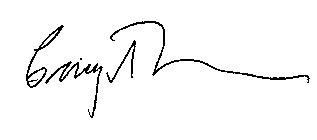
Craig Thomason
Partner
Sydney
30 September 2025
as at 30 September 2025
The Company did not receive any substantial holding notices as of the date of this report.
The Company has issued the following securities:
a) 256,561,572 fully paid ordinary share held by 8,342 shareholders
b) 2,500,000 unlisted options held by 1 holder
c) 6,986,589 unlisted warrants held by 2 holders
a) Ordinary shares
On a show of hands every member present at a meeting in person or by proxy shall have one vote and upon a poll each share shall have one vote.
b) Options No voting rights.
The number of shareholders holding less than a marketable parcel of the Company’s ordinary shares ($500 in value) is 956 based on the Company’s closing share price of $3.84 on 30 September 2025.
During FY25 up to the date of this report, the Company has bought back 1,190,120 shares on market at a
Consolidated Limited
ABN 42 000 837 472
Ross Smyth-Kirk OAM Executive Chairman
Jamie Gibson Managing Director & Chief Executive Officer
Nucharee Sailasuta Non-Executive Director
Peter Warren Non-Executive Director
Secretary
Stephanie Wen
Kingsgate Consolidated Limited is a Company limited by shares, listed on the Australian Securities Exchange (ASX) under the code KCN.
Kingsgate Consolidated Limited
Suite 12.07 – Level 12
14 Martin Place
Sydney NSW 2000
Australia
Tel: +61 2 8256 4800
Email: info@kingsgate.com.au
Web: www.kingsgate.com.au
Akara Resources Public Company Limited
188 Spring Tower, Unit 6, Level 14
Phaya Thai Road
Thung Phaya Thai, Ratchathewi
Bangkok 10400
Thailand
Tel: +66 5661 4500
Email: admincgm@akararesources.com
Web: www.akararesources.com
Akara Resources Public Company Limited
No. 99 Moo 9 Khao Chet Luk Subdistrict
Thap Khlo District
Phichit Province 66230
Thailand
Tel: +66 5661 4500
Email: admincgm@akararesources.com
Web: www.akararesources.com
MUFG Corporate Markets (AU) Limited
Liberty Place, Level 41
161 Castlereagh Street
Sydney NSW 2000
Australia
Postal address: Locked Bag A14
Sydney South NSW 1235
Australia
Tel: +61 1300 554 474
Fax: +61 1300 554 474
Email: support@cm.mpms.mufg.com
Web: au.investorcentre.mpms.mufg.com
PricewaterhouseCoopers
One International Towers Sydney Watermans Quay
Barangaroo NSW 2000
Australia
Tel: +61 2 8266 0000
Fax: +61 2 8266 9999
Web: www.pwc.com.au
Tel:
Email:
ABN:
